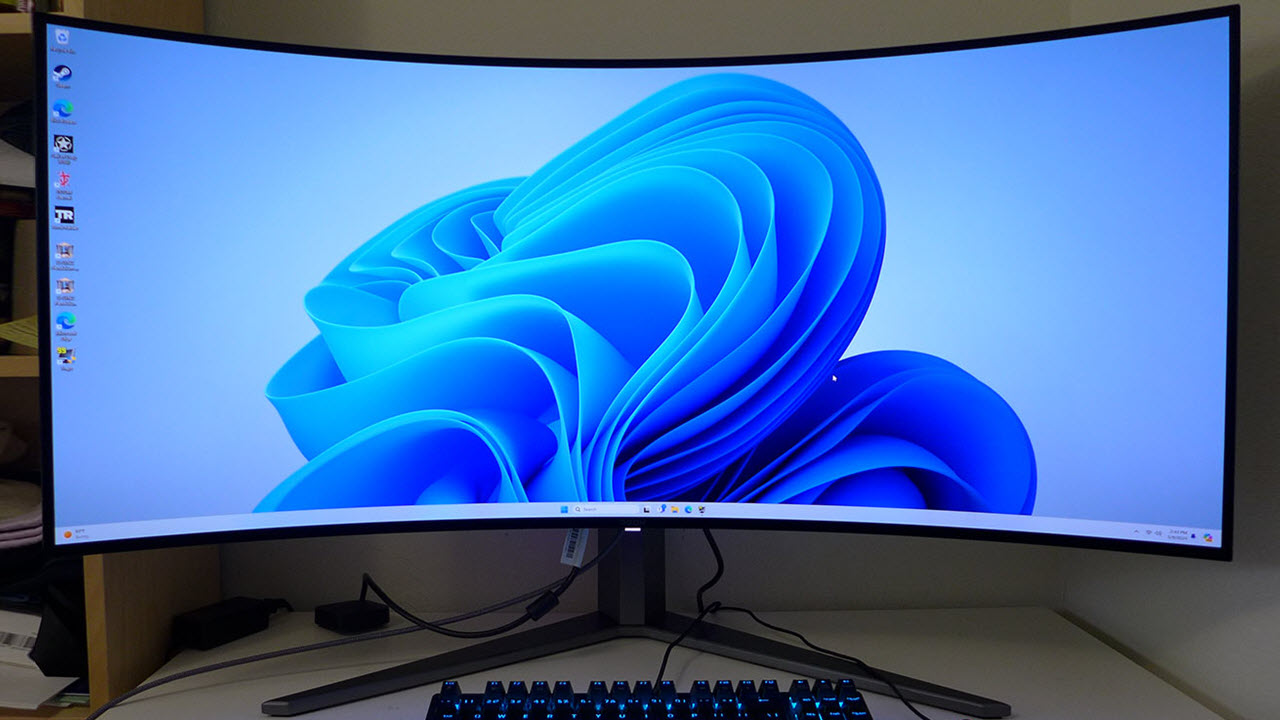
The best gaming monitors come in so many shapes and sizes that buying a monitor for specific game types has become easy. First-person titles benefit from curved screens in 21:9 and 32:9 aspect ratios. By stretching the view out to the edge of the player's peripheral vision, something akin to VR goggles can be created. Except, of course, a monitor is less expensive and doesn’t sit on your head. It can also be used for other things like watching movies or productivity.
If you have the space for a wide display, there is either 21:9 or 32:9. The latter typically comes in a 49-inch size and is very wide but not very tall. It’s great for driving sims but less ideal for shooters requiring more vertical space in the viewpoint. 21:9 takes care of that but most of those products are 34 inches, which is not really encompassing. For a genuine surround feel, check out the 45-inch AOC OLED I will review. Part of the Agon Pro line, the AG456UCZD is incredibly immersive with an 800R curve, WQHD 3440x1440 resolution, 240 Hz refresh rate, Adaptive-Sync, HDR and wide gamut color. Let’s take a look.
AOC Agon Pro AG456UCZD Specs
When you see a curve radius of 800R, take notice: it means a very tight curve. A circle of AG456UCZDs would make the user claustrophobic with an enclosure just 1.6 meters across, 63 inches, or just over five feet. When you sit in front of this monitor, two or three feet away, the sides aren’t far from your ears.
The resolution is WQHD or 3440x1440 and screen is 45 inches diagonal in a 21:9 aspect ratio, which makes pixel density 83ppi. That’s about the same as a 27-inch FHD monitor, so the AG456UCZD won’t match the clarity of a smaller screen. But that’s not the point. The OLED panel provides a stable 240 Hz, so motion resolution is perfect at speeds over 200 fps. It also has the infinite contrast and rich color I’ve come to be spoiled by in the OLED genre. With over 98% coverage of DCI-P3, it’s extremely colorful. It achieves this without a Quantum Dot layer, so it delivers high brightness, around 400 nits for SDR and 635 measured for HDR.
Out-of-the-box color accuracy is solid, with no need for calibration. For my sample, I made only a change in gamma to achieve a superb image for both SDR and HDR content. There are plenty of picture modes and tweaks if you prefer a different look. AOC has included the choice of constant or variable brightness, which is something only a few OLEDs offer.
Video processing is exemplary thanks to the 240 Hz refresh rate and also flawless Adaptive-Sync operation. The AG456UCZD delivers G-Sync and FreeSync over a 48 to 240 Hz range. It has been certified by Nvidia and also for FreeSync Premium. There’s no strobe option to address slower frame rates, so operating it below 144 Hz will produce a little motion blur.
As part of the Agon Pro line, the AG456UCZD is a premium build from top to bottom. You get a solid stand, LED lighting, decent internal speakers, plenty of USB options, and even a handheld remote. It’s premium priced, too, at around $1,400 at this writing. But this is typical for the category, and there aren’t any other monitors like it. Most ultra-wides are smaller at 34 or 35 inches with gentler curves. A 45-inch OLED screen with 800R is definitely unusual.
Assembly and Accessories
The AG456UCZD’s three parts come out of a suitably large carton filled with crumbly foam. The stand is substantial and assembles with a captive bolt. To attach the panel, find the two large screws in the package, and the included Phillips-head screwdriver. The fulcrum looks small for a panel this large, but it is more solid than it appears. Once completed, it’s very solid and stable. A small box has the cable bundle, which includes USB-C, DisplayPort, and HDMI,, a power cord, and a remote with two AAA batteries.
Product 360
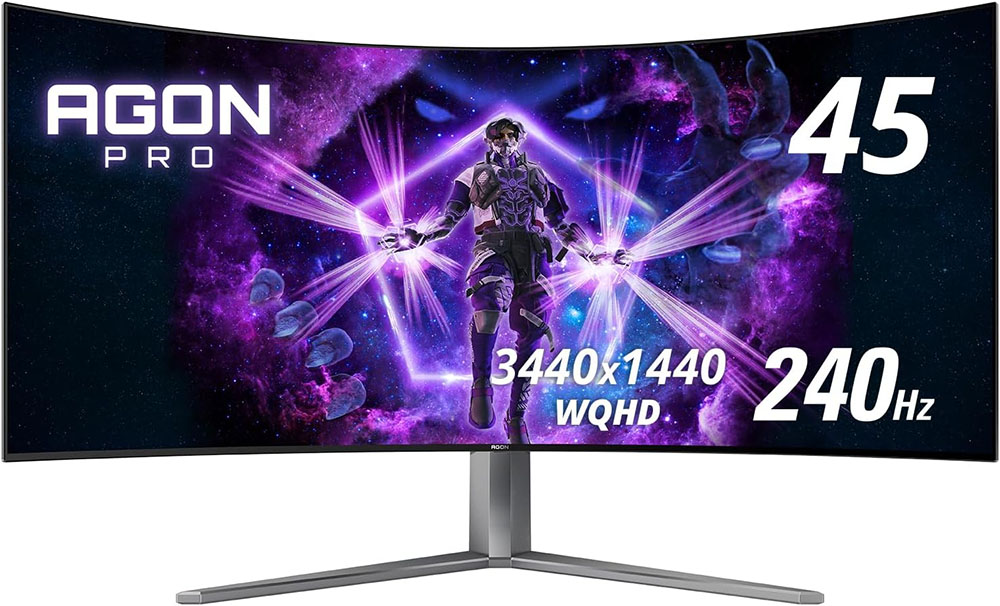
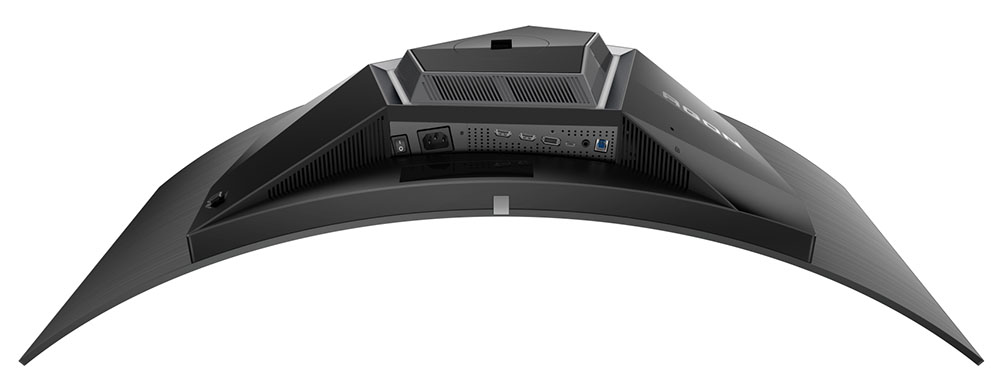
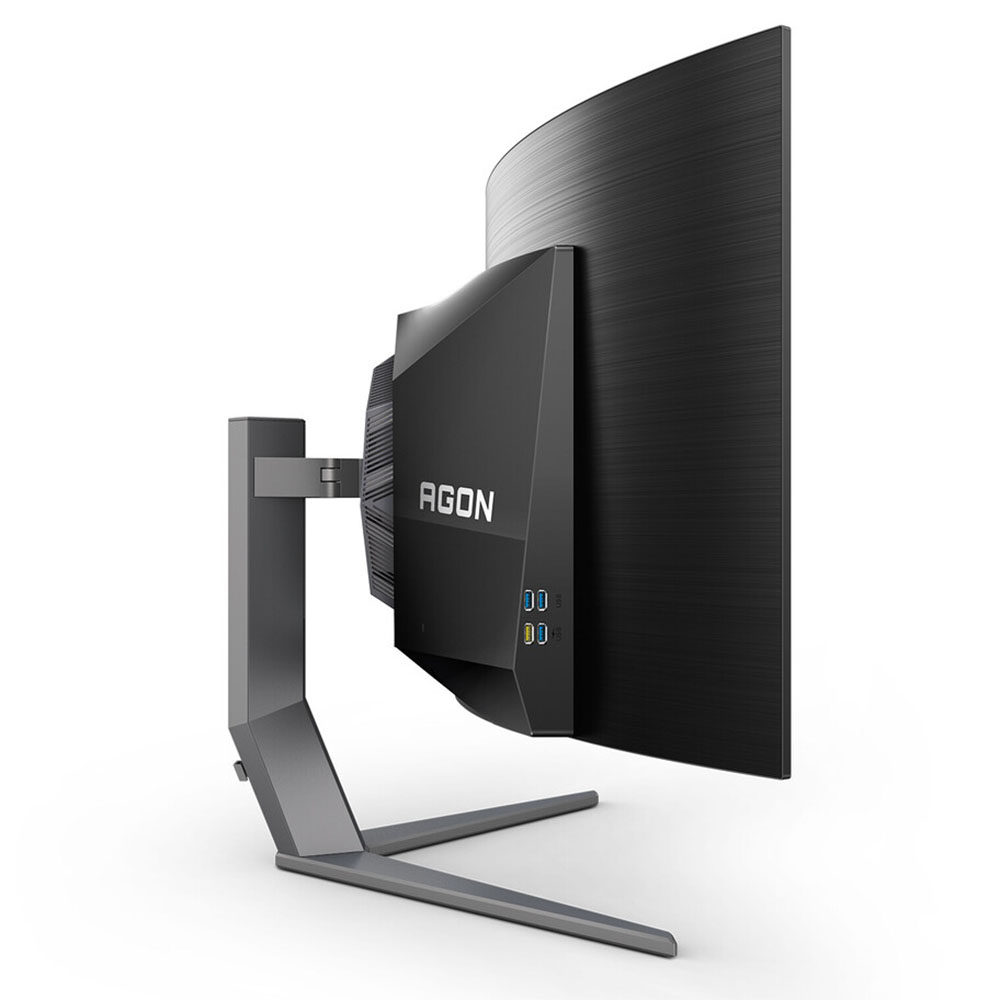
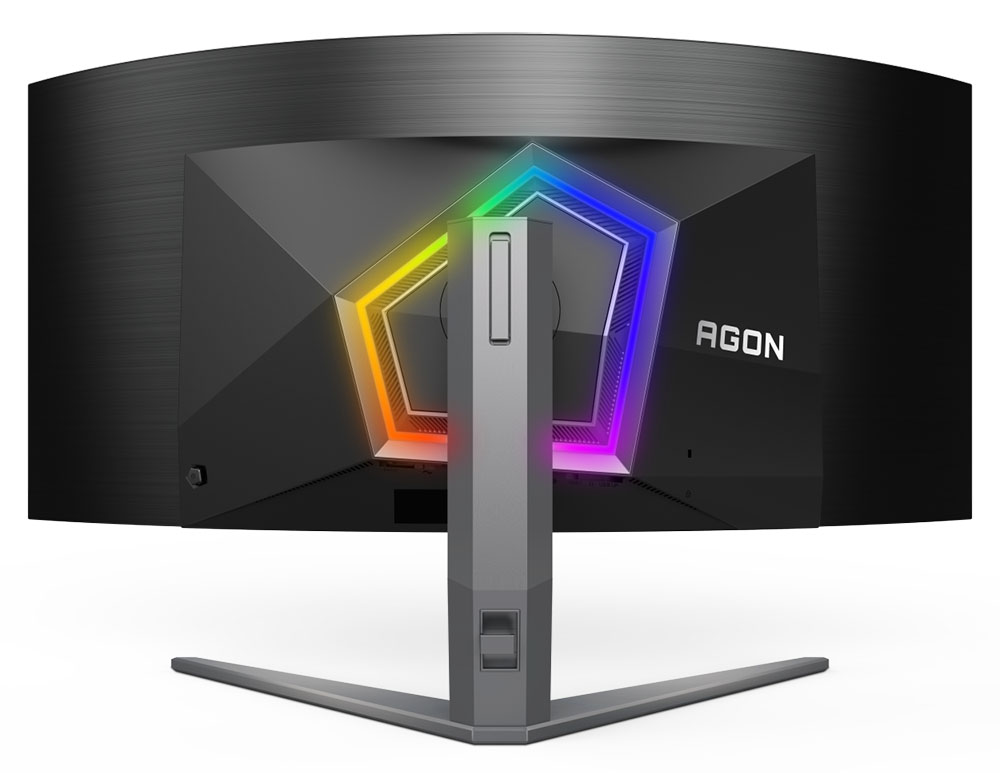
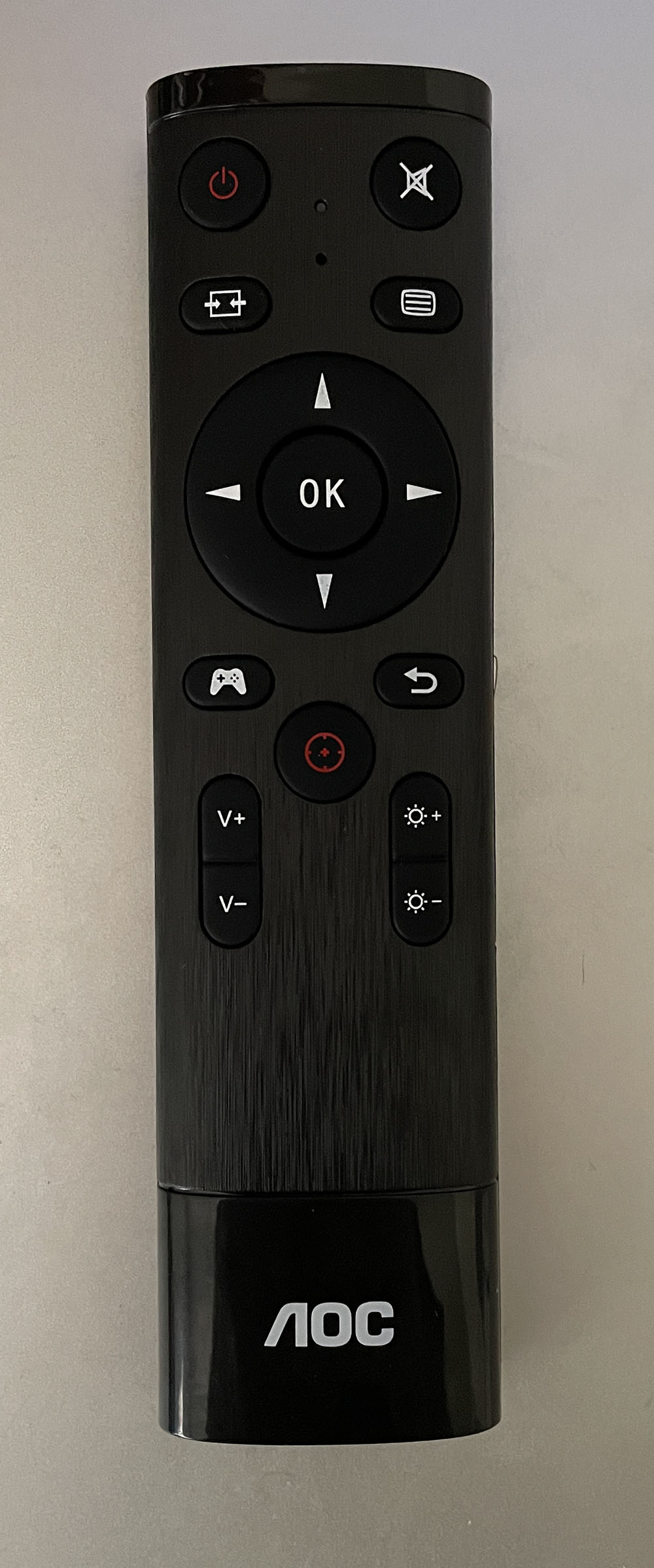
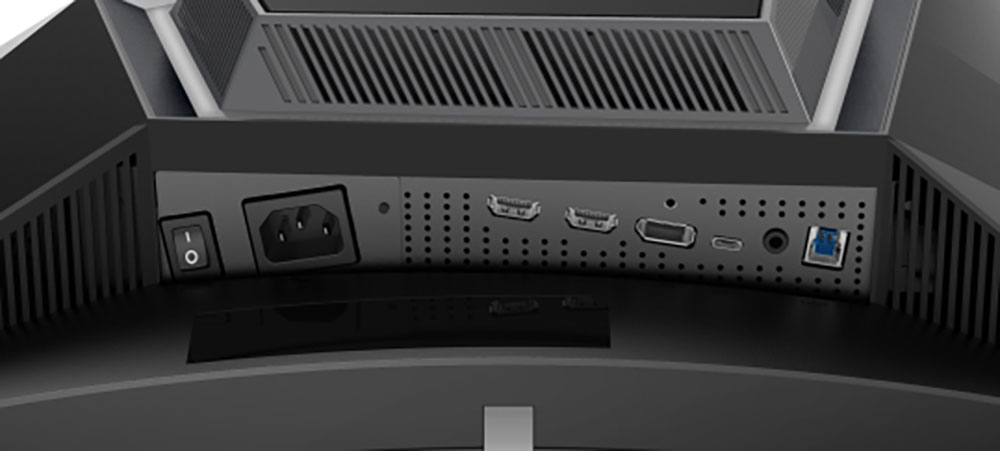
The AG456UCZD has a large footprint but isn’t quite as wide as a 49-inch 32:9 model. What you notice most is its significant height and tight curve. The screen fills your viewpoint both vertically and horizontally. When you sit three feet back, sound reflects into your ears from the screen. It’s a unique experience you can’t get from any other monitor.
The stand is very wide and deep, more than up to the task of supporting the panel’s weight. It offers full ergonomics with four-inch height adjustment, 5/15 degrees tilt, and 17 degrees swivel to either side. Movements are firm and free of play. The AG456UCZD exudes premium quality all the way.
The LED lighting is arrayed around the attachment point in the back with colorful effects that play from an asymmetrical hexagon. This shape integrates chiseled features and the word Agon to create a unique look. The panel is finished in black with a brushed texture, while the stand is a matte gray. The base is solid metal with a plastic-covered, metal-cored upright. The single control is a joystick protruding from the component bulge. Also on the bulge, on the left side, are four convenient USB ports, one of which supports fast charging.
Underneath are two HDMI 2.0 and one DisplayPort 1.4, plus a USB-C with DP capability and 90 watts of power. A USB-B upstream port supports KVM functions for your favorite peripherals. The HDMI ports are limited to 120 Hz and 2560x1440 for gaming consoles. You also get a 3.5mm headphone jack. The internal speakers play with eight watts of power and sound better than most, with decent volume, low distortion, and good frequency range.
OSD Features
AOC uses a unique menu style for its Agon products, arranged like the traditional ribbon layout but in a vertical format. It follows the same configuration, so it will be familiar to AOC users. You can operate it with the joystick, but the remote is far more convenient.
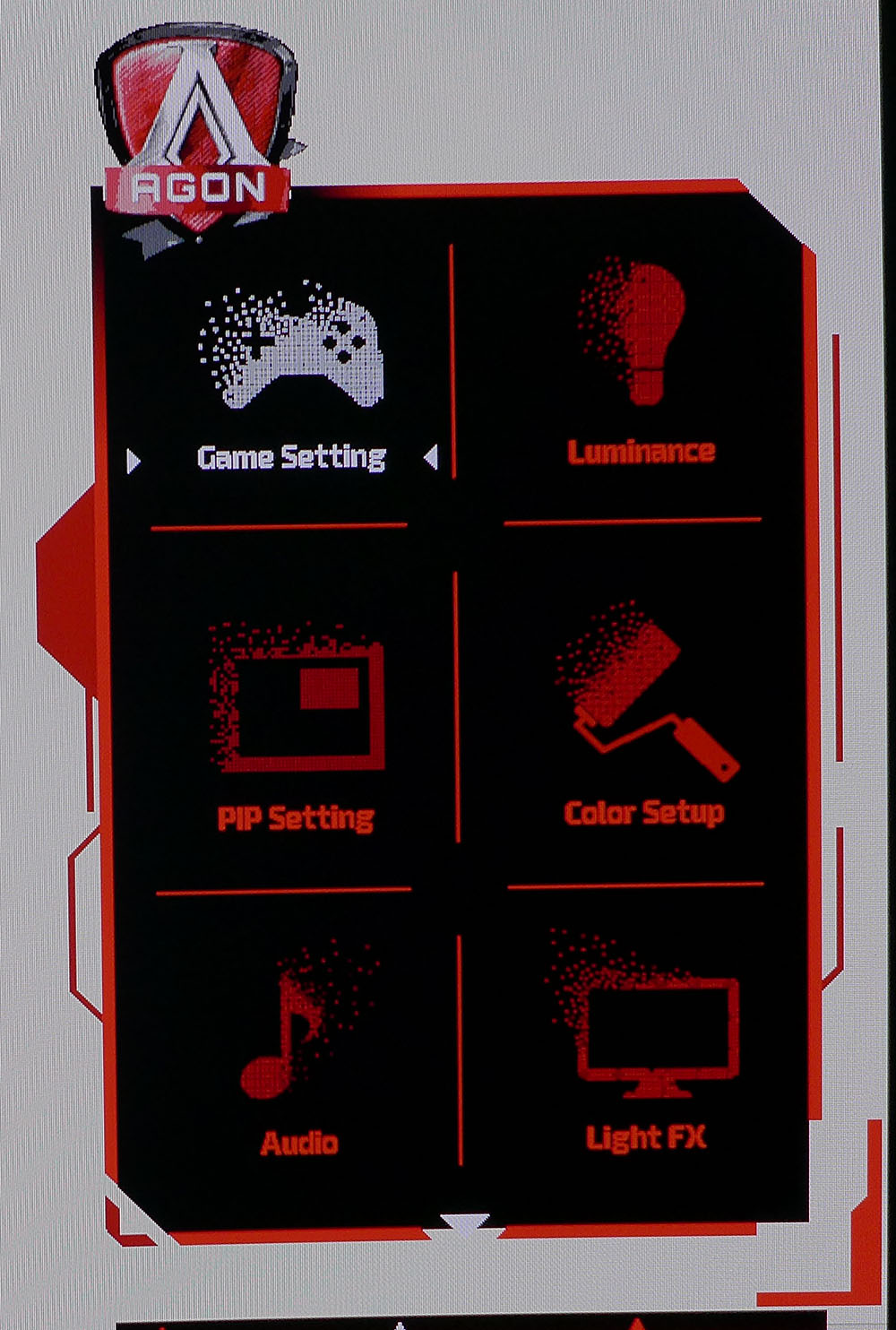
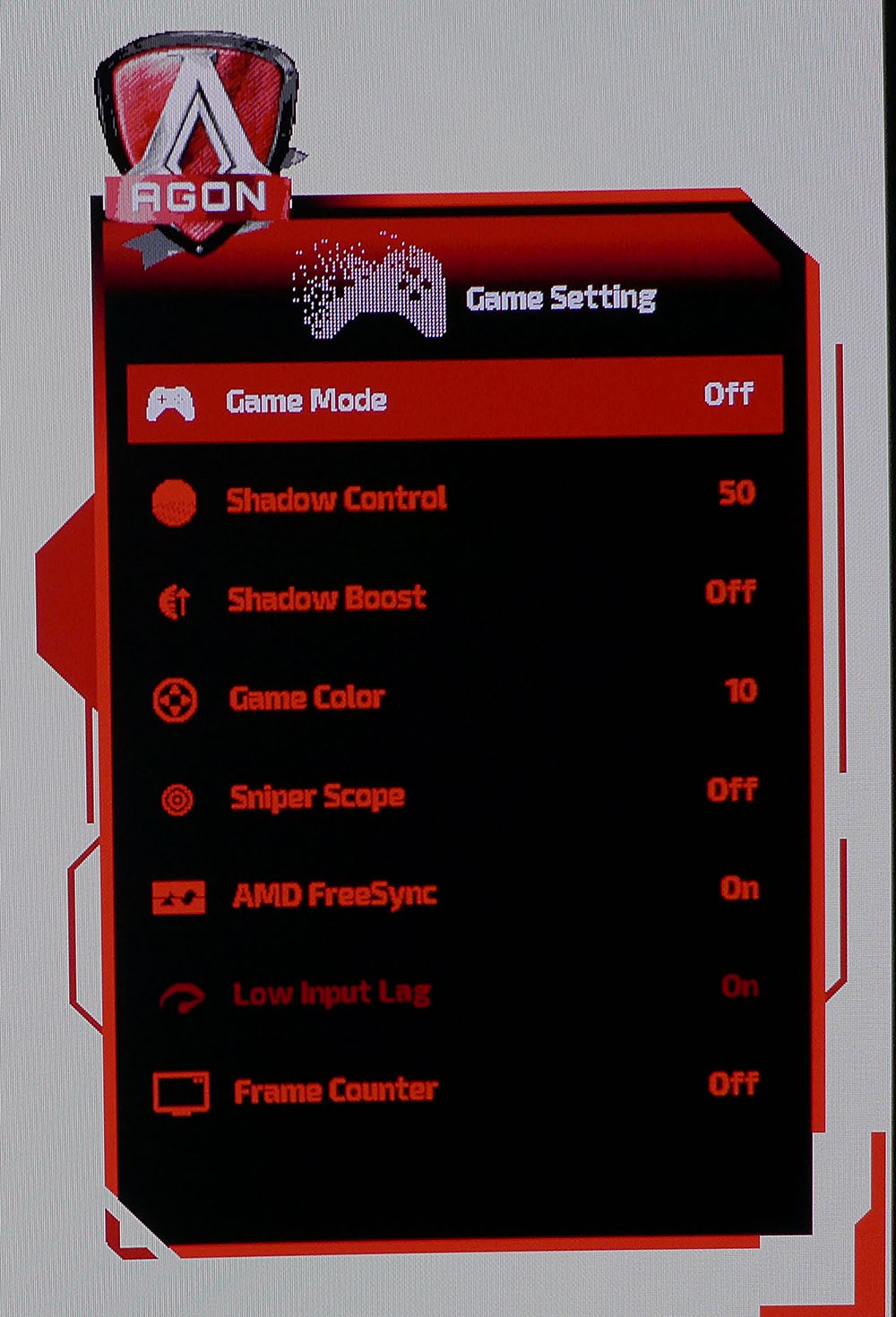
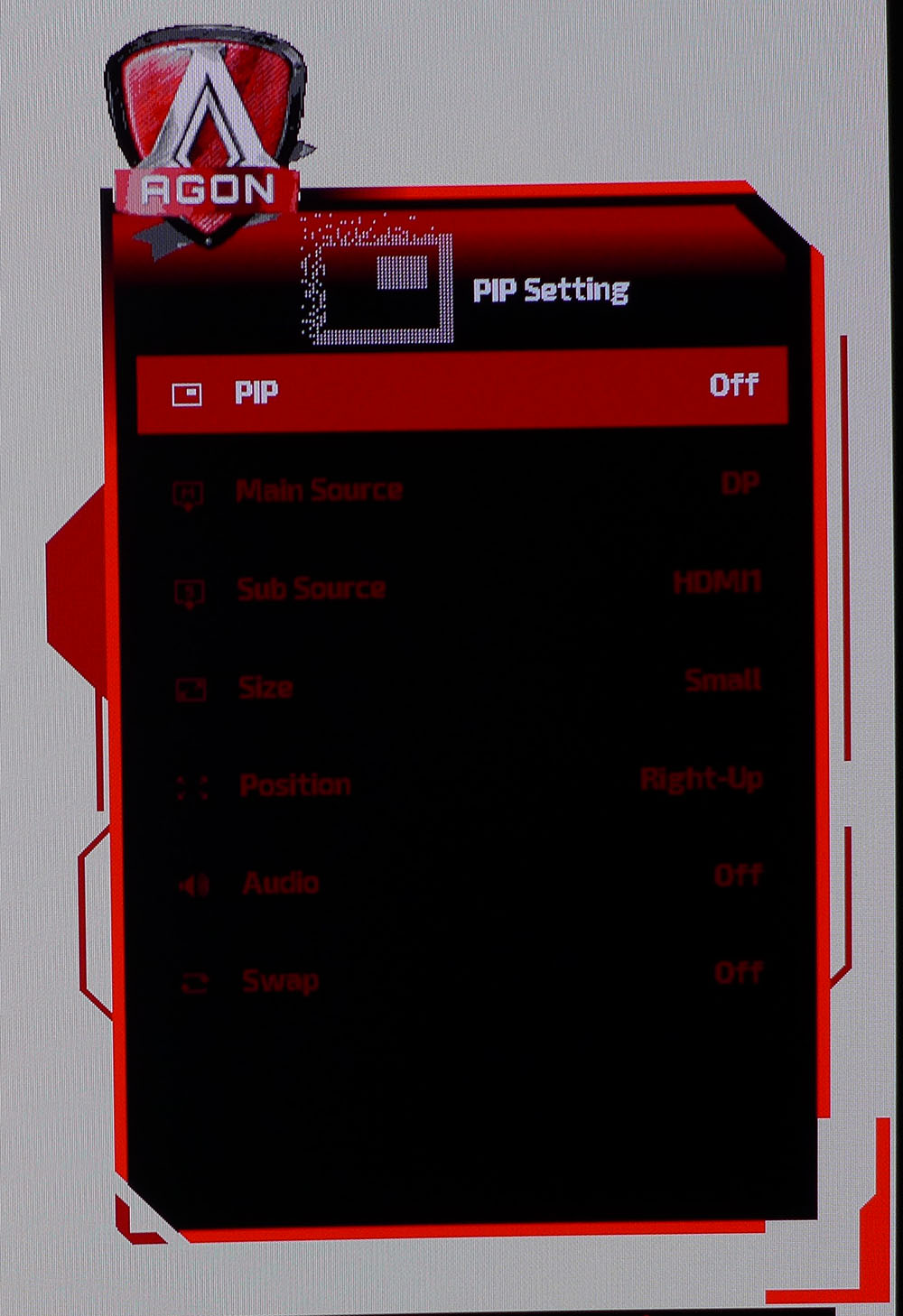
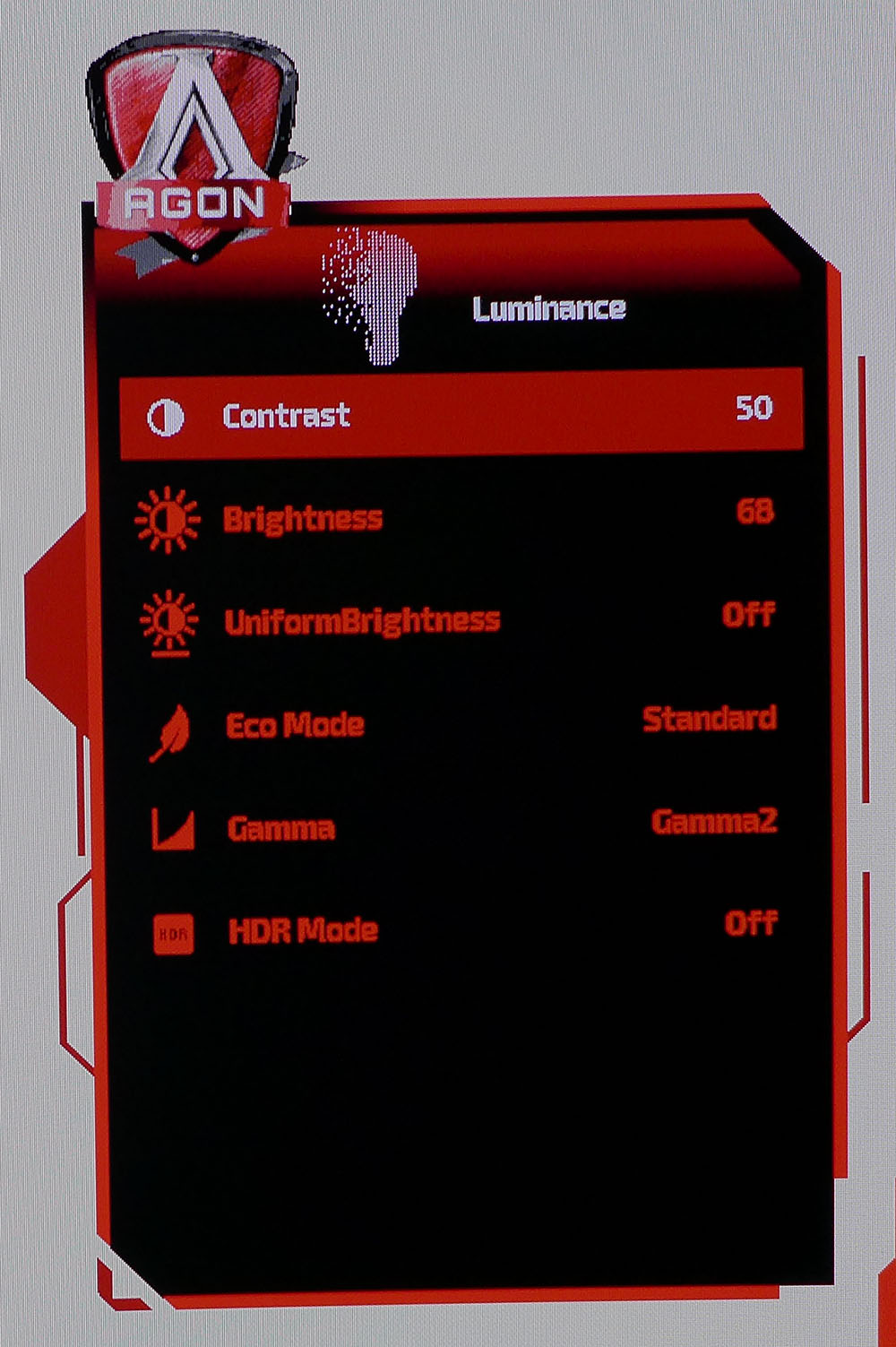
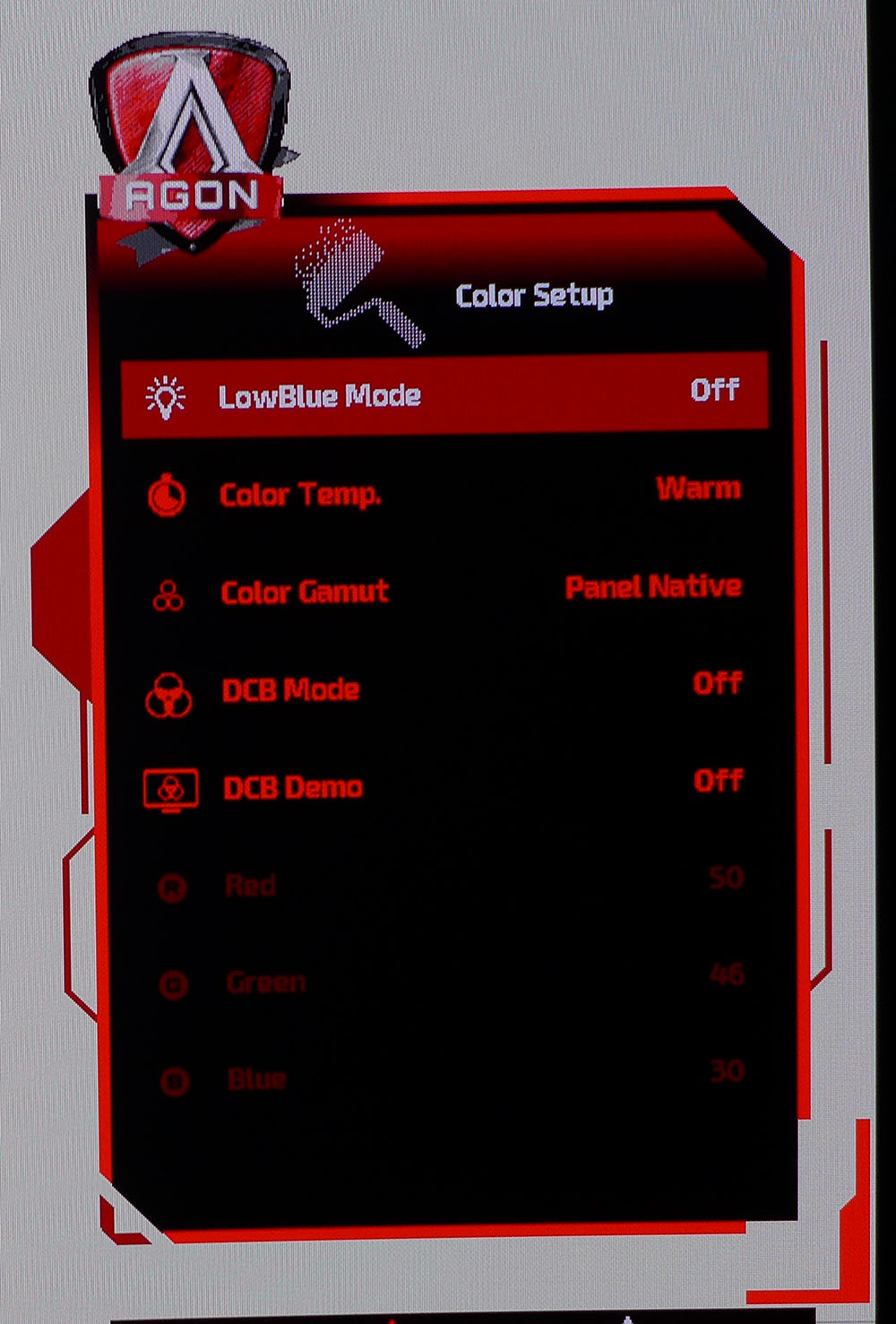
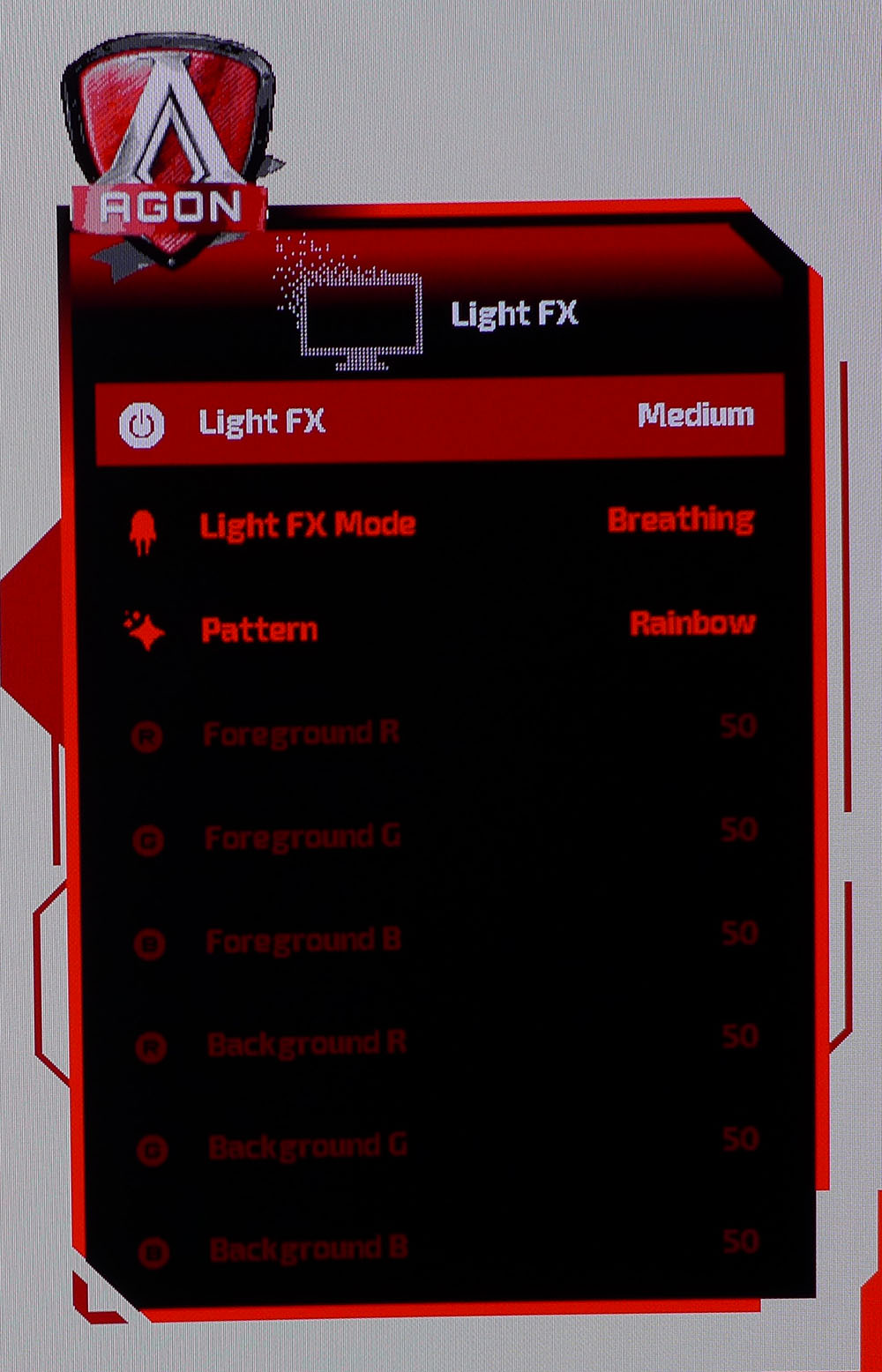
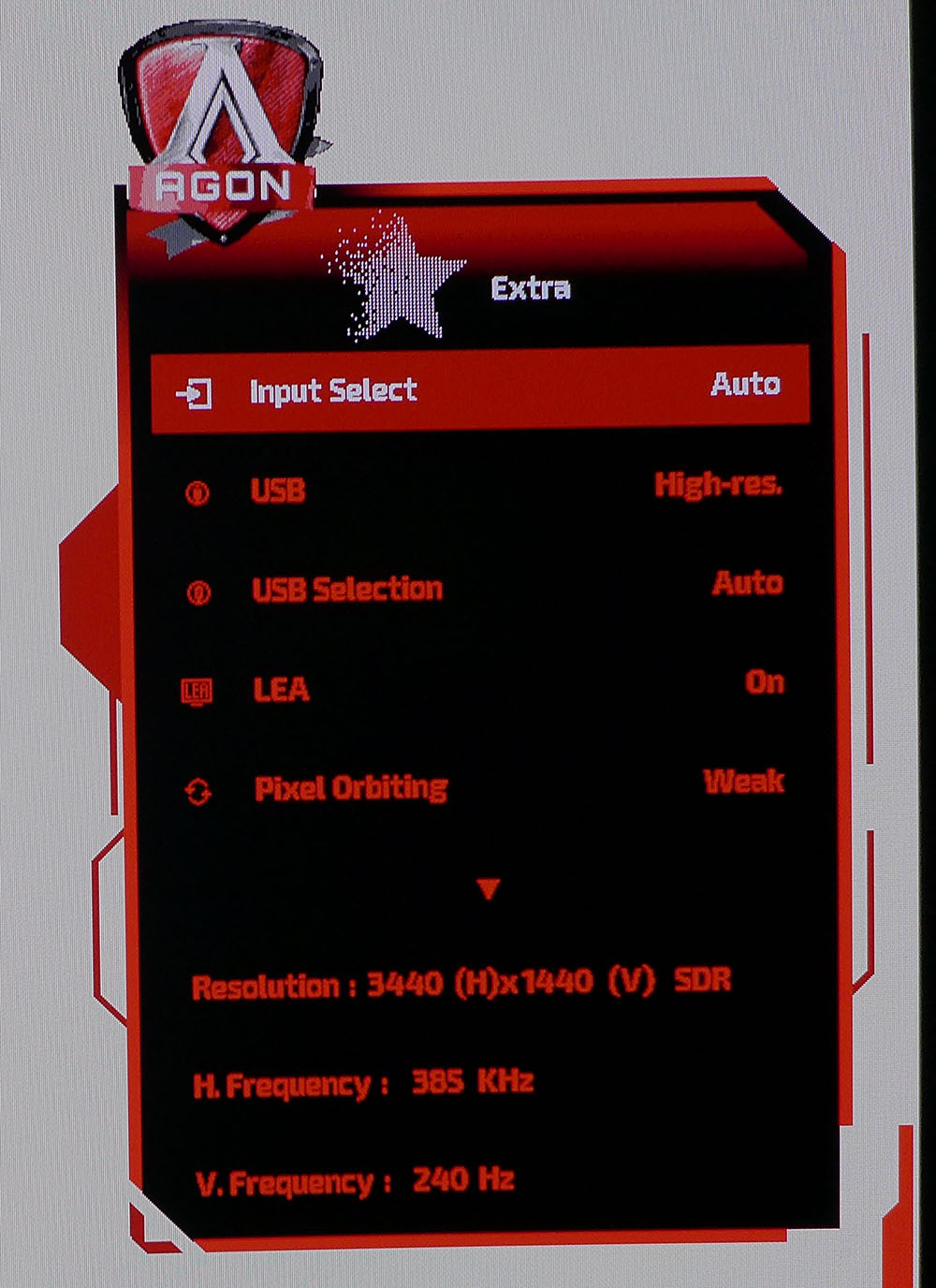
Pressing the remote’s menu button summons the main screen with eight sub-menus, six of which appear at any one time. Game Setting has an array of game modes that alter the image to suit different game types. I recommend leaving this off. You can make shadow detail more visible with Shadow Control and Shadow Boost. While this is effective, it spoils the OLED look of deep blacks. If you’re having trouble seeing dark areas of the image, turn off your room lights. You can also tweak color saturation with the Game Color control. There’s a sniper mode that magnifies the center of the screen and a frame rate indicator. The aiming points are activated by clicking the joystick down or pressing the big red button on the remote.
The Luminance menu is where you’ll find three gamma presets. I preferred the look of Gamma 2 over the default Gamma 1 setting, but that involves a compromise I’ll tell you about later. You can also turn on Uniform Brightness for SDR and HDR content. Leaving it off makes the image brighter, but introduces some visible shift in luminance when content changes. If you find the image bright enough when turned on, that’s the preferred setting. HDR Mode includes three HDR emulations for SDR content. They are a matter of user preference; try them and see if you like them. When HDR10 content is displayed, you get five HDR modes. DisplayHDR is the most accurate and best choice.
The AG456UCZD has extensive PIP and PBP options appropriate for any jumbo monitor. You can view two sources at once in either windowed or side-by-side layouts. The window can be positioned to your liking, and you can swap audio between sources.
Color Setup has three color temp presets plus a user mode with RGB sliders. I found the best results in the Warm color temp. You can choose between Native, DCI-P3 and sRGB color gamuts too.
Light FX refers to the LEDs arrayed around the asymmetrical hexagon in the back. You can choose colors and effects here or create a show using AOC’s G-Menu app from the Windows desktop. The Extra menu has an input selector, USB port control, and pixel orbiting for OLED care. You can also set a refresh routine to run every four hours if you wish. I have yet to see burn-in on any OLED screen in my possession, including a three-year-old LG OLED TV and an Alienware desktop monitor.
AOC Agon Pro AG456UCZD Calibration Settings
The AG456UCZD includes the same calibration controls as all AOC monitors, which means selectable color gamuts, three gamma presets, and a user color temp. All is well out of the box, and calibration is unnecessary, but I found the gamma looked a tad dark. Measurements confirmed that it was running around 2.36. Grayscale calibration did not positively impact, so I left the color temp set to Warm and changed gamma to the 2 preset. This brightened the image noticeably and tightened up color saturation tracking. This is a compromise, so you should try Gamma 1 and Gamma 2 to see which you prefer. For the full color gamut, leave that option on Panel Native. If you need sRGB, it’s there and accurate enough for critical work. My SDR settings are below. Brightness settings are with Uniform Brightness turned off.
For HDR content, there are four additional modes available. DisplayHDR is the best one with accurate color and luminance tracking.
Gaming and Hands-on
Gaming with the AG456UCZD is nearly a case of sensory overload. It’s wide, tall, and wraps around you. The game environment is literally in your face. Even the sound is reflected within the screen’s vision cone, creating a surround effect. This monitor is tactile in every way.
The image is stunning whether you play in HDR or SDR mode. SDR games like Tomb Raider look a bit too colorful when using the full gamut. This is a product of the AG456UCZD’s near-100% coverage of DCI-P3 and OLED contrast, which amplifies all aspects of picture quality. I could tone it down by simply selecting the sRGB gamut from the OSD. The monitor looks its best when showing HDR content, though. Doom Eternal was rich with detail and saturated color.
If you’re concerned about pixel density, don’t be. 83ppi seems low, but in practice, on this screen, you will not notice the dot structure, even when sitting close. I was two feet away, and the picture was nothing but razor-sharp and three-dimensional. Remember that OLED panels don’t have the aggressive polarization of LCDs, and the pixel gaps are very small.
Video processing was flawless in every respect. I have yet to find a 240 Hz OLED that didn’t deliver perfect motion resolution. You’ll need a reasonably fast video card to realize the AG456UCZD’s full potential. The fun starts at 200fps, for sure. Between 144 and 200 Hz, there is a little blur, and below 144 Hz there is a little more, but not as much as an LCD at the same refresh rate. It would be nice if AOC had included a strobe option because console users would surely benefit. Adaptive-Sync worked perfectly though so you won’t have to worry about frame tears.
Using an 800R monitor for work presents a few challenges but nothing that can be adapted. Documents should be kept in the center of the screen, especially spreadsheets. You can’t avoid the distortion of straight lines with such a tight radius. OLED clarity takes care of small fonts and icons, but it’s harder to focus on the task if you’ve turned your head to one side while typing. The AG456UCZD also isn’t ideal for photo editing. Small graphics are fine if you can keep them within the center third of the screen.
The AG456UCZD exudes quality from its premium build and rugged feel. The styling is game-focused but not overly distracting. Thanks to its unique shape and large size, it makes itself a conversation piece. The LED lighting creates a pleasing glow without drawing too much attention. I barely noticed its reflection from the wall behind.
The internal speakers are much better than average. They’re among the best I’ve experienced. At half volume, they are very loud and full. Remember that the screen’s curve acts as a sonic reflector. It’s almost like wearing headphones. I could turn them down quite far and still hear everything clearly. AOC has made an excellent effort here.
Takeaway: The AG456UCZD delivers a true multi-sensory experience with its tight curve, stunning image, superb video processing, and excellent sound. It puts games in your face and around your head. It’s great for anything: first-person, shooters, driving, flying, or just exploring virtual worlds. It’s fine for work if you keep your focus at the center of the screen. Gamers who try an AG456UCZD will want it, for sure.
The AG456UCZD is unique at this time, so I’ve brought in 34 and 49-inch OLED monitors for comparison. The group includes Asus’ PG34WCDM and PG49WCD, Samsung’s OLED G8 and G9, and Aorus’ CO49DQ.
Pixel Response and Input Lag
Click here to read up on our pixel response and input lag testing procedures.
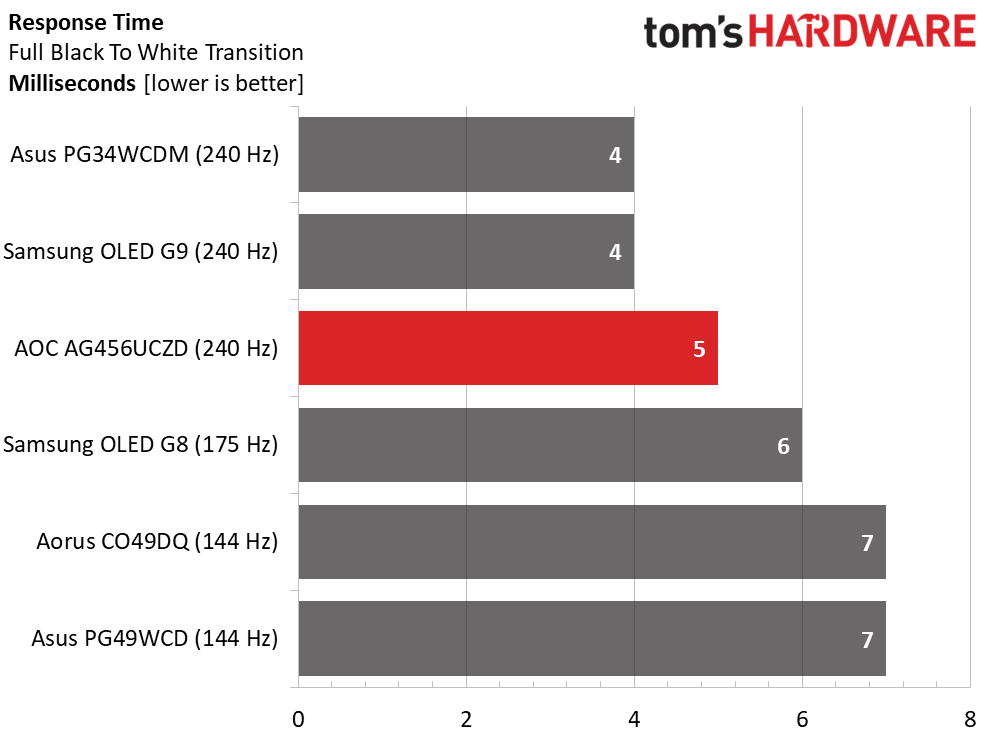
240 Hz usually means a 4ms panel draw time but the AG456UCZD takes 5ms. When comparing Blur Busters’ motion patterns running at 240fps, there is no visible difference. Smoothness is assured at speeds above 200 Hz with perfect motion resolution for moving objects and panning backgrounds.
The AG456UCZD wins the total lag contest with a 22ms result. It doesn’t get much faster. Only a few 27-inch 16:9 flat OLEDs have gone quicker. I wouldn’t give up this giant curved screen for 3ms. This monitor is competition ready.
Test Takeaway: The AG456UCZD exhibits the perfect motion resolution and super low input lag I’ve come to expect from 240 Hz OLED monitors. It performs at the highest level and since its shape and size are unique, has no real competition. If you’re comparing it to smaller screens, they will have more pixel density but not the immersion factor of the AOC.
Viewing Angles
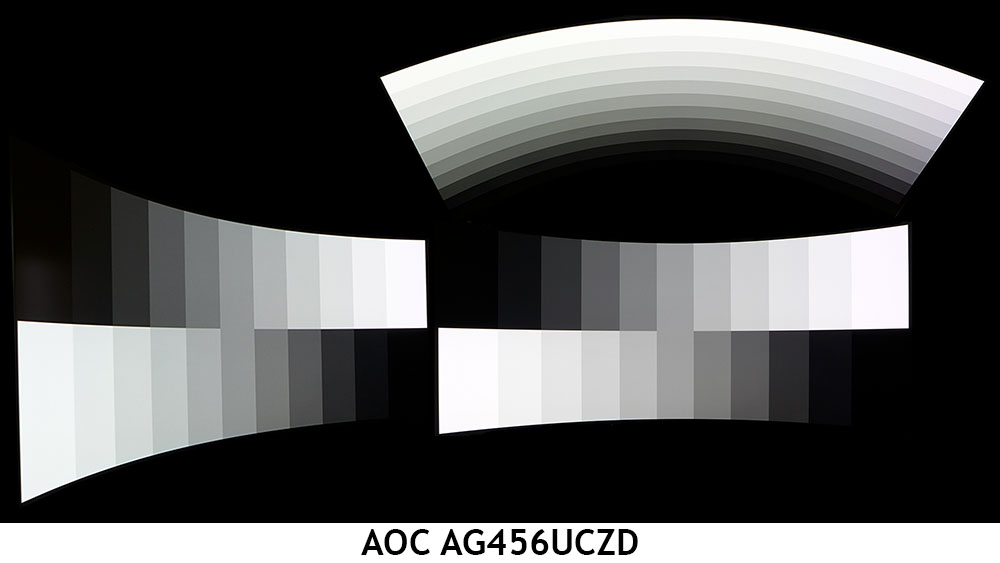
The AG456UCZD benefits in this test from its non-Quantum Dot panel. While that feature would expand the color gamut, it also introduces a subtle color shift off-axis. With its extreme 800R curve, AOC was right to select this panel. At 45 degrees, there is no visible change in brightness and only a slight blue tone. The vertical view also retains full luminance and gamma. This is excellent performance.
Screen Uniformity
To learn how we measure screen uniformity, click here.
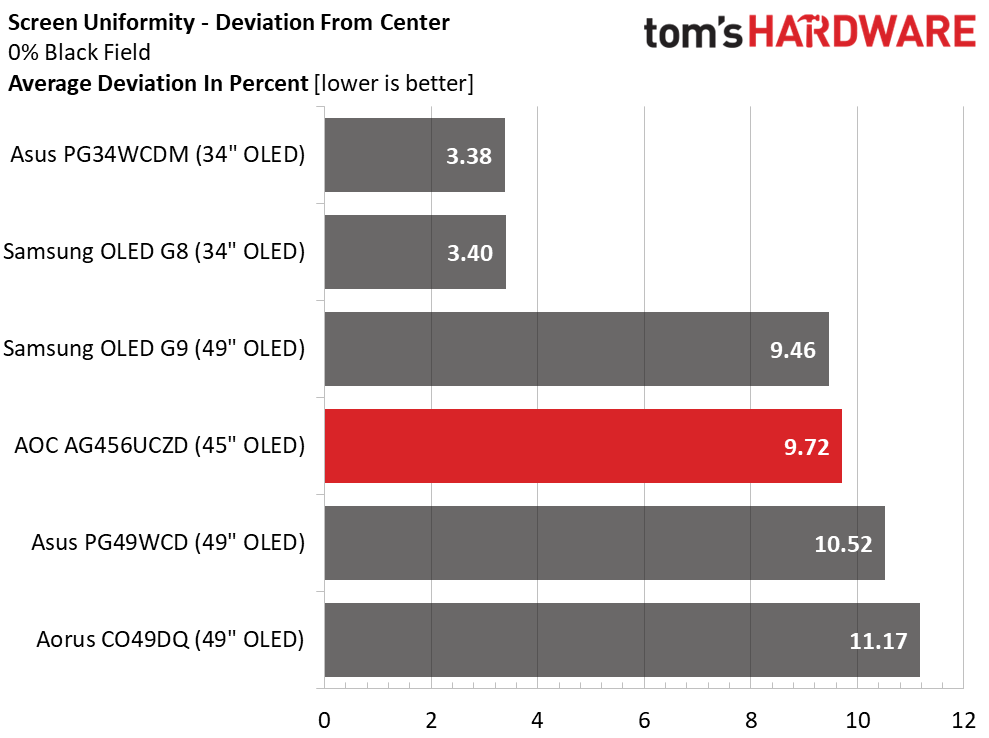
I’ve seen excellent screen uniformity from all the OLEDs I’ve reviewed. This technology is less prone to hotspots, bleed, or glow than LCD variants. The AG456UCZD has no visible issues when measuring a 10% gray field pattern. Brighter steps are also free of visible problems. There are no color uniformity anomalies either.
To read about our monitor tests in-depth, please check out Display Testing Explained: How We Test PC Monitors. We cover brightness and contrast testing on page two.
Uncalibrated – Maximum Backlight Level
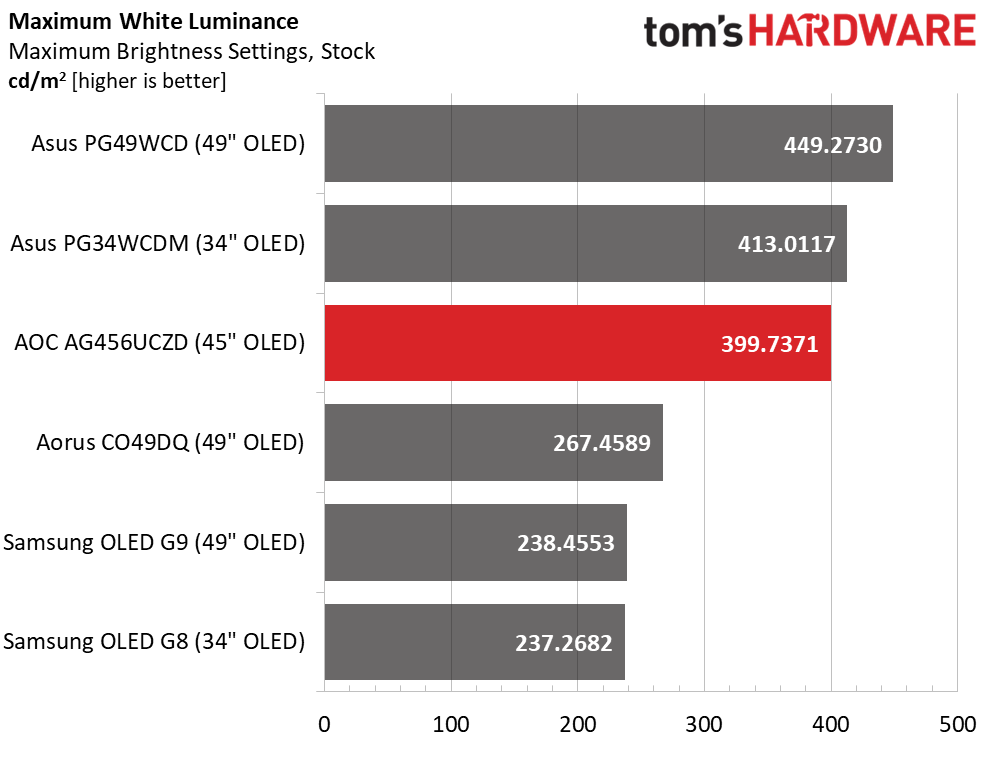
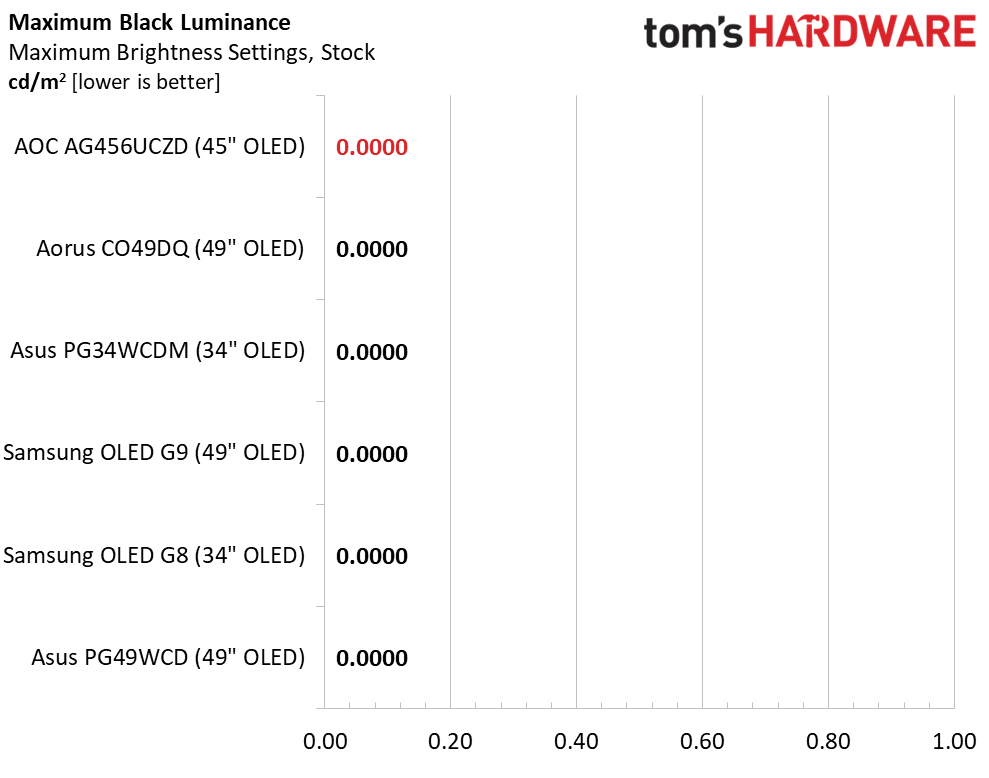
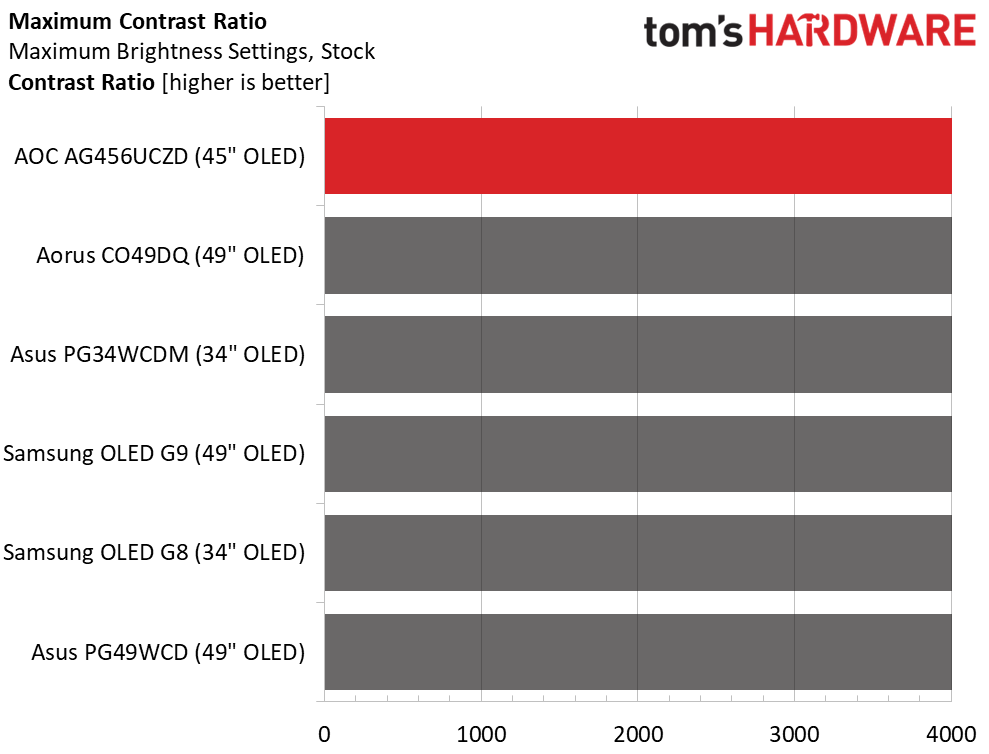
The AG456UCZD's variable brightness feature is turned on by default. That means the brightness of a 25% window is greater than that of a full-field white pattern. Should you prefer constant brightness, that option is available and results in a peak white reading of 256 nits. Either mode is bright enough for an indoor environment. Turning Constant Brightness on only limits the peak number, not contrast. That is still unmeasurable due to the completely black screen displayed under zero brightness conditions.
After Calibration to 200 nits
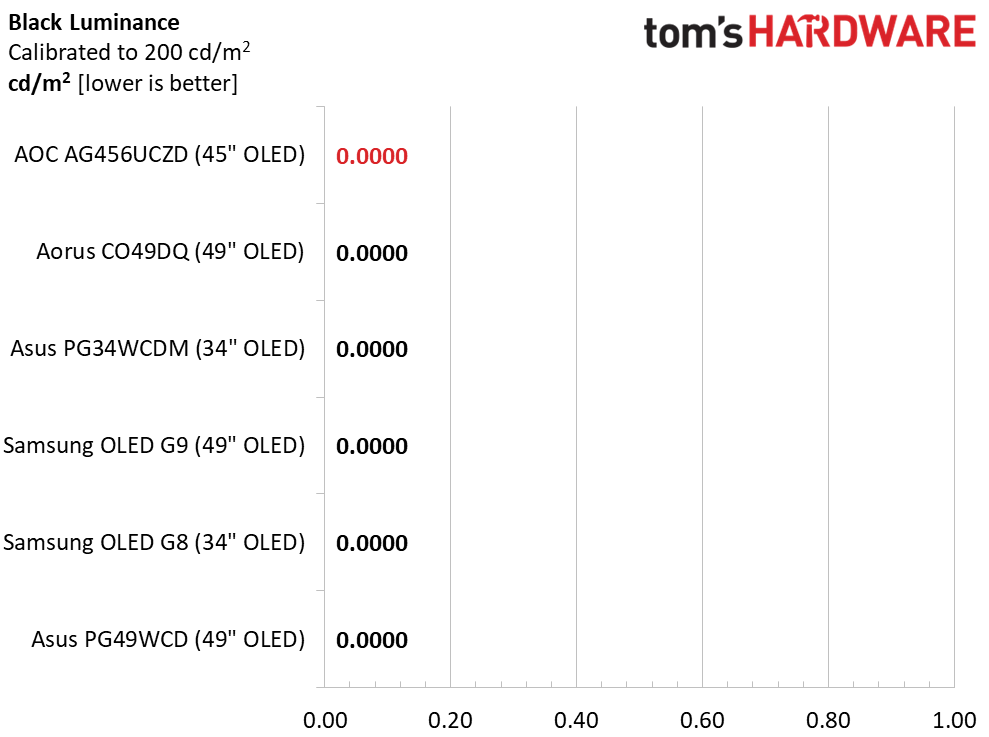
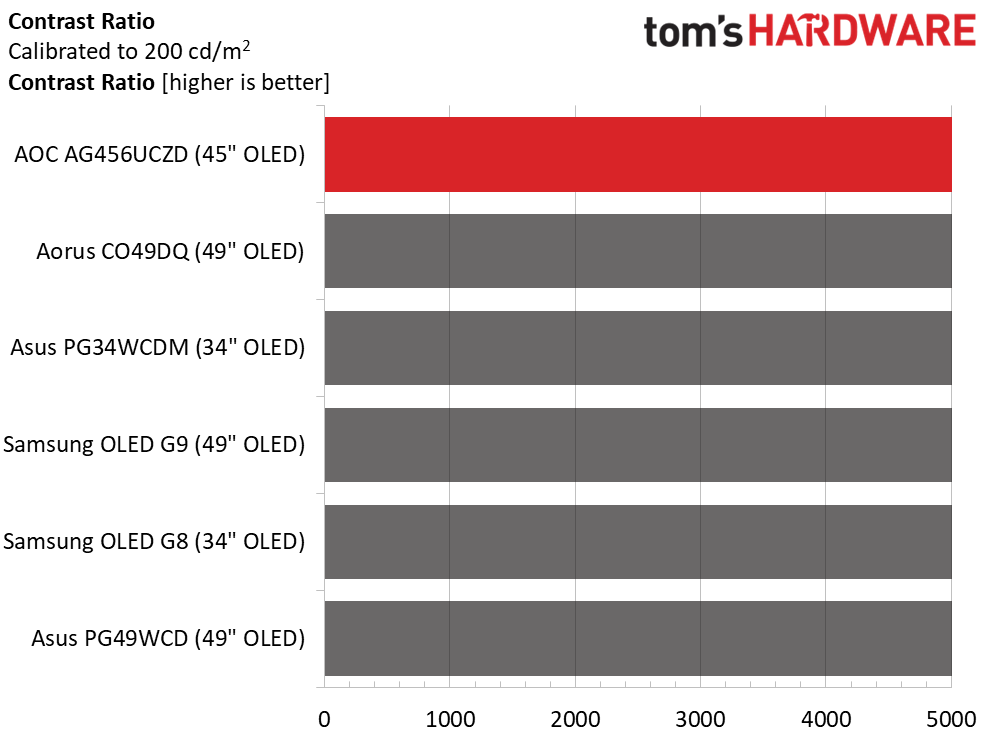
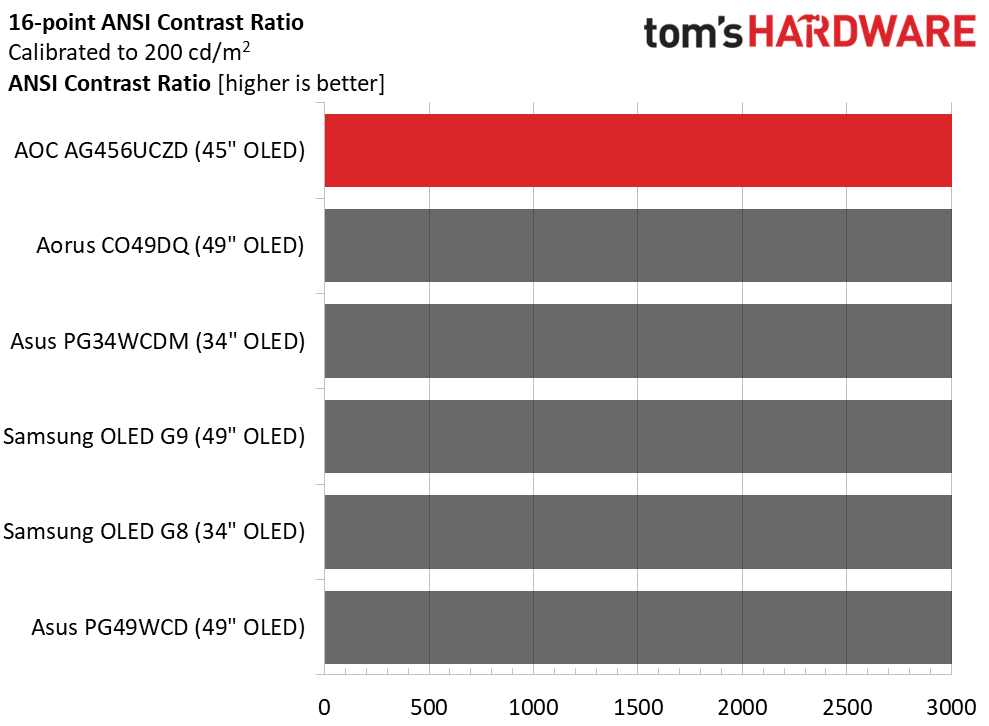
Calibration does not affect contrast or black levels in any way. Since the AG456UCZD is bright enough with Constant Brightness turned on, that’s the way I would use it for SDR. Turn it off for HDR to enjoy brighter highlights. There is no difference between any of these screens in the static or ANSI (intra-image) tests. Once brightness is equalized, they deliver the same dynamic range and unmeasurable black levels.
Test Takeaway: The AG456UCZD’s variable brightness feature is a bit more aggressive than average which is the reason for its high peak white level. This is great for a bright image but can be fatiguing in the long term. AOC provides a choice with its Constant Brightness option, something many OLEDs don’t offer. Either way, it delivers tremendous contrast and a stunning image.
The AG456UCZD is ready to rock out of the box with grayscale and color that is well within specification. Each example is calibrated before shipment, so consistency is assured. My only observation concerns gamma which I’ll explain below.
Grayscale and Gamma Tracking
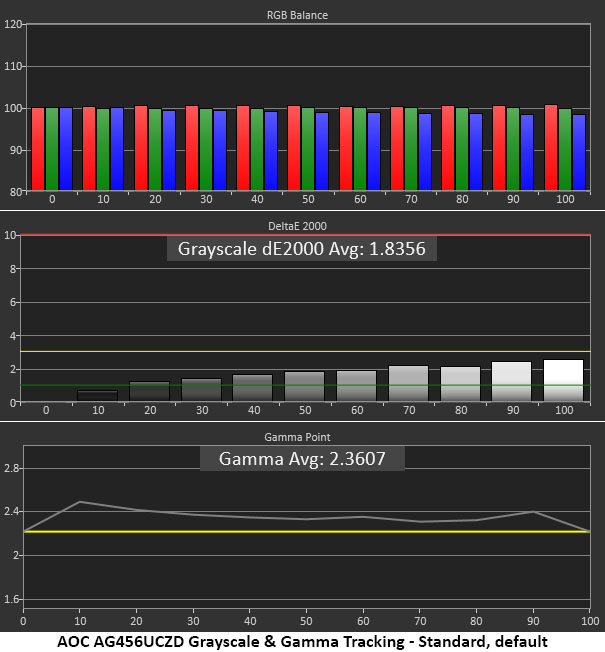
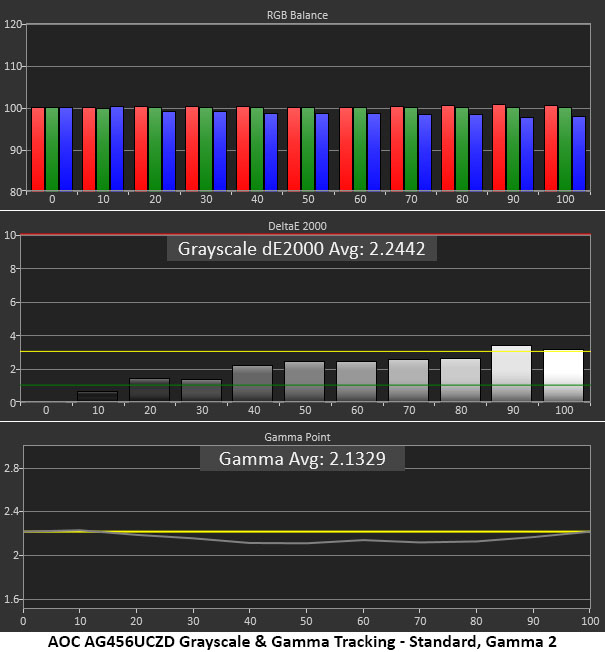
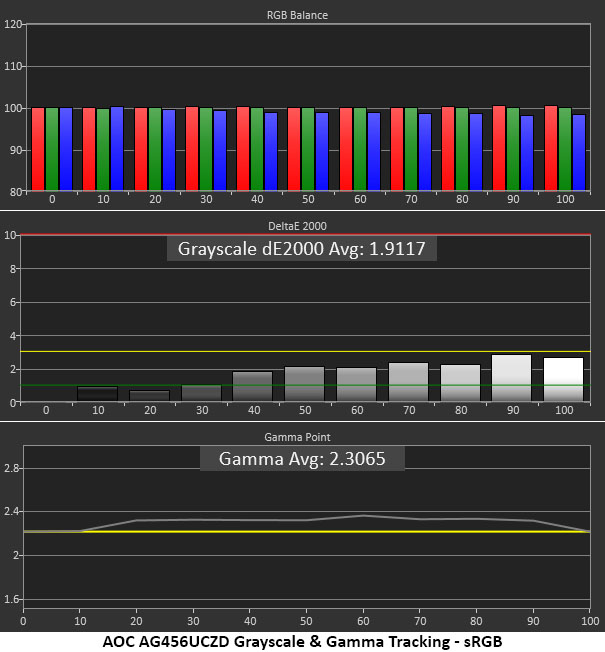
Our grayscale and gamma tests use Calman calibration software from Portrait Displays. We describe our grayscale and gamma tests in detail here.
By default, the AG456UCZD’s grayscale errors are all below the visible threshold. However, gamma is a bit dark. While this results in slightly over-saturated color, which many users will prefer, it makes the picture a bit murky. I’m picking nits here, but it motivates me to try a few things.
The User color temp starts out very blue and ultimately does not improve grayscale accuracy. It doesn’t affect gamma either, so I returned to the Warm color temp preset and changed gamma from 1 to 2. That lightened the image in a good way, even though the trace is a bit below the reference. It is closer to spec by the numbers, though, and as you’ll see in the gamut test, saturation points are closer to the mark. Though I took a slight hit in grayscale accuracy, it’s a worthwhile compromise. You can try both gamma settings to see which you prefer.
When I set the color gamut to sRGB, it grayed out all other image controls except for brightness. The result is visually perfect grayscale tracking and slightly dark gamma, which is good enough for color-critical applications.
Comparisons
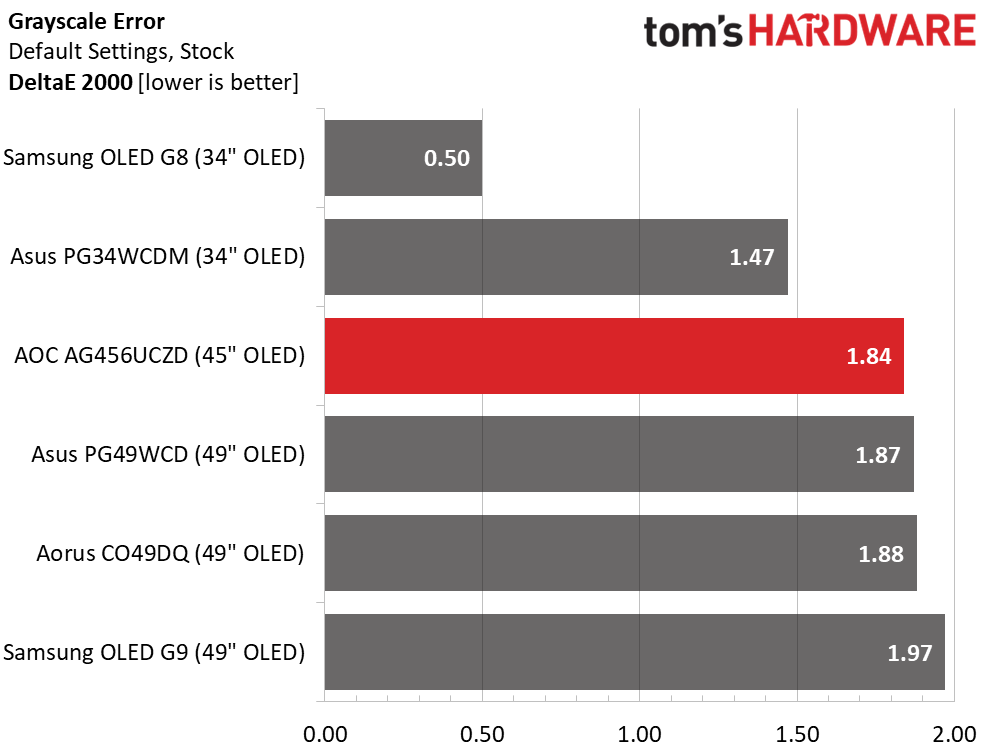
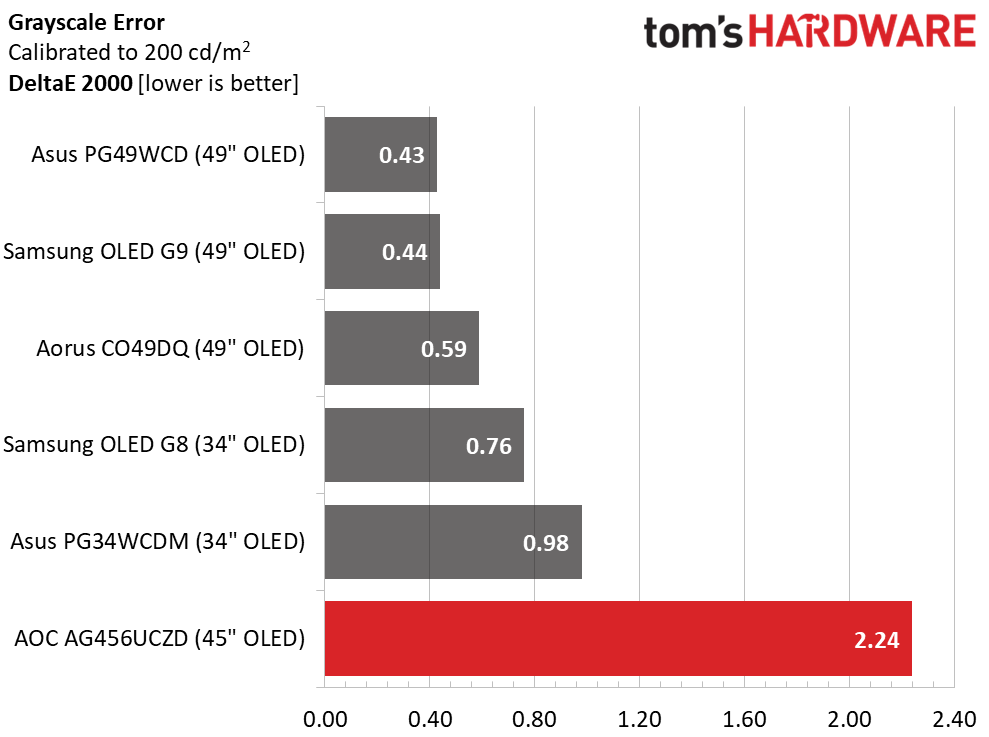
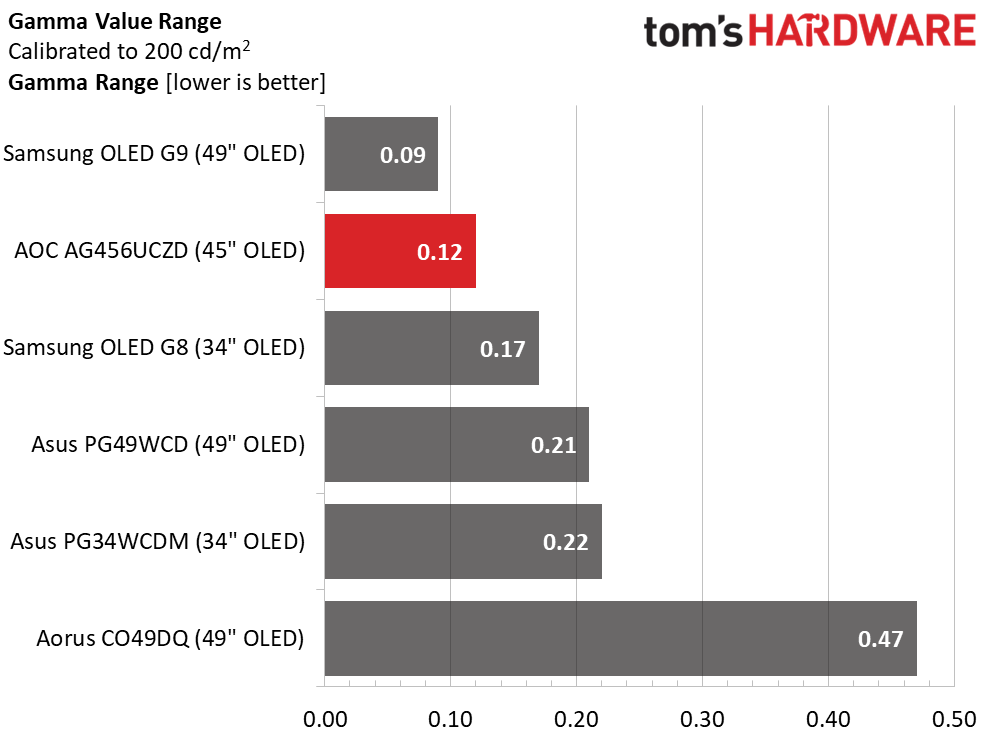
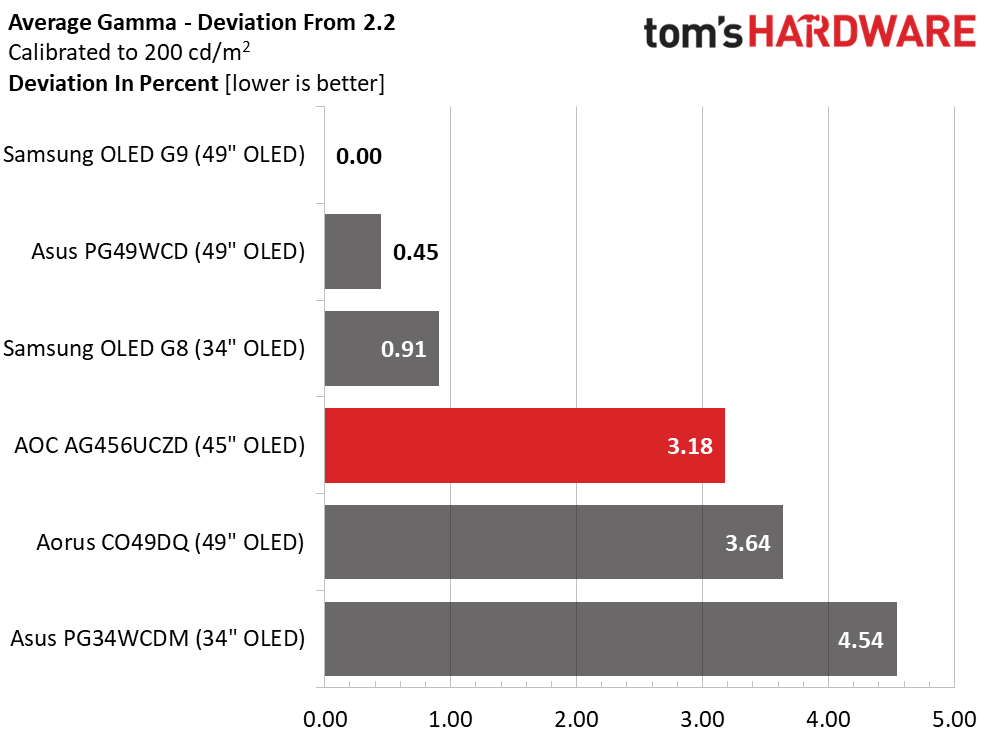
You’ll notice that I took a small step backward in the AG456UCZD’s grayscale tracking accuracy, but visually, it is an improvement due to the lighter gamma tracking. As I said, you may feel differently, so all that’s required is to change gamma between preset 1 and preset 2. It looks great either way. The gamma result shown above is on the Gamma 2 setting.
Color Gamut Accuracy
Our color gamut and volume testing use Portrait Displays’ Calman software. For details on our color gamut testing and volume calculations, click here.
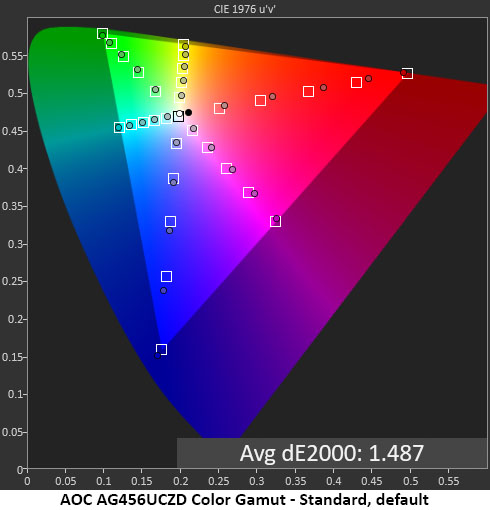
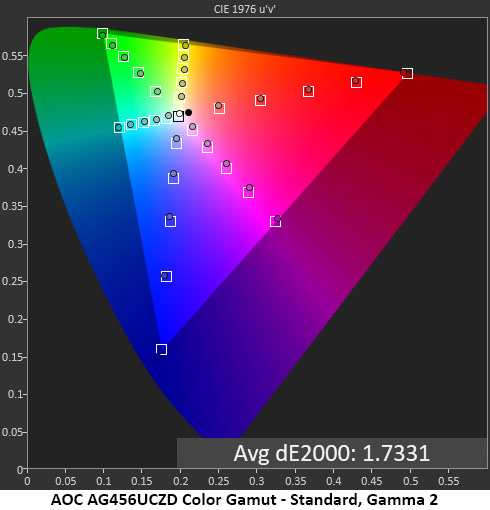
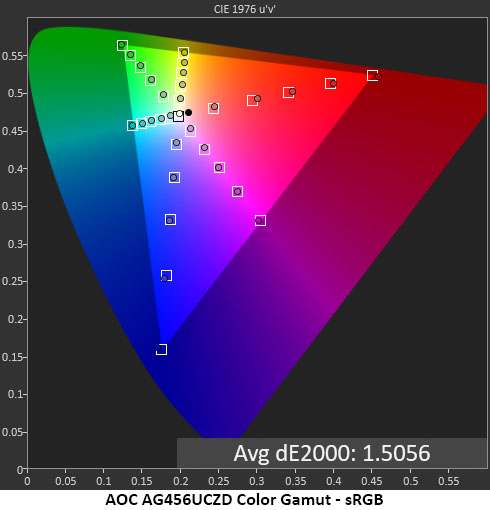
I had a similar experience measuring the AG456UCZD’s color gamut. The default error of 1.49dE is professional grade, but it is slightly oversaturated in red. Visually, this isn’t an issue. When I changed the gamma preset, targets tightened considerably, but the average increased to 1.73dE. This is a tiny difference. Both numbers are superb by any standard. sRGB mode also hits the mark with a 1.51dE result.
Comparisons
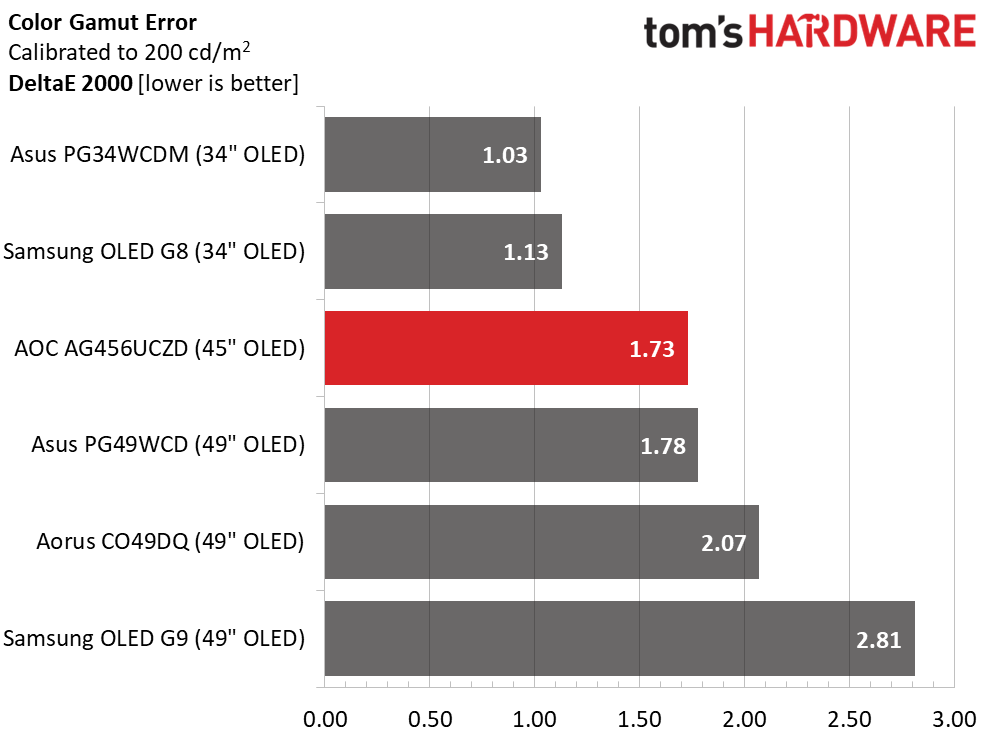
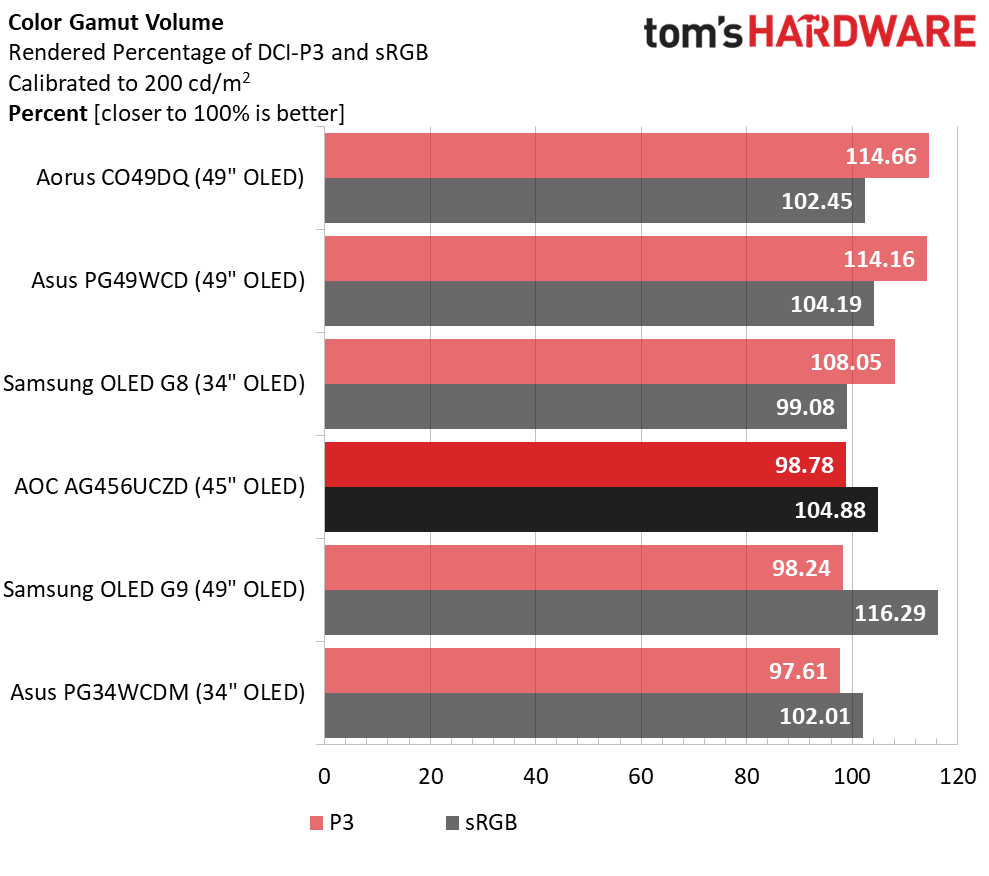
Even though I went slightly backward with the AG456UCZD’s color result, I prefer the image on the Gamma 2 preset. Both choices are accurate enough for pro-level work. It is a personal preference issue. I preferred the lighter look; you may not. Room lighting will also affect perception, so I urge you to try both settings.
Though the AG456UCZD doesn’t have a Quantum Dot layer, it covers over 98% of DCI-P3. A few monitors have gone over 100%, and they look a little more colorful. But I suspect buyers will be looking at size and shape here. There is plenty of color to satisfy gamers and graphics pros alike.
Test Takeaway: Compromises and nit-picks aside, the AG456UCZD delivers superb accuracy regardless of which gamma setting you choose. It doesn’t need or benefit from calibration. That is always a plus. It’s also qualified for color-critical work in DCI-P3 or sRGB gamuts.
Our HDR benchmarking uses Portrait Displays’ Calman software. To learn about our HDR testing, see our breakdown of how we test PC monitors.
Applying an HDR10 signal to the AG456UCZD switches it over automatically and opens up four additional picture modes. DisplayHDR is the default and best choice. I ran all HDR color tests in this mode as it was the only accurate choice. The other three present a different look but ultimately have flaws that hide detail and exaggerate color unattractively. They also introduce resolution-reducing edge enhancement.
HDR Brightness and Contrast
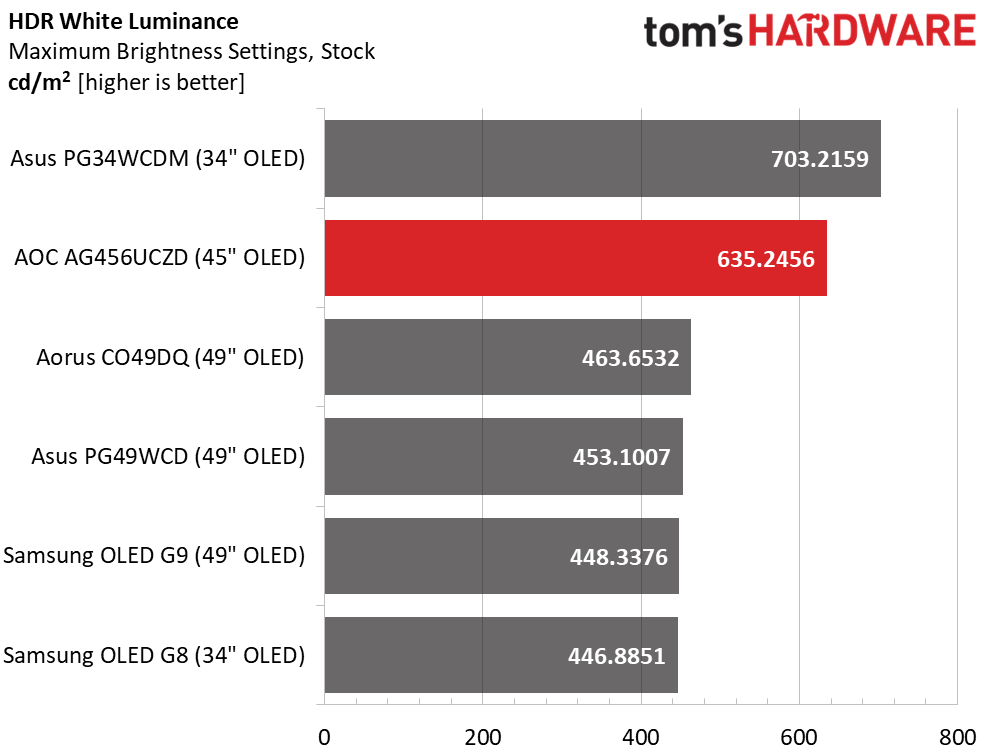
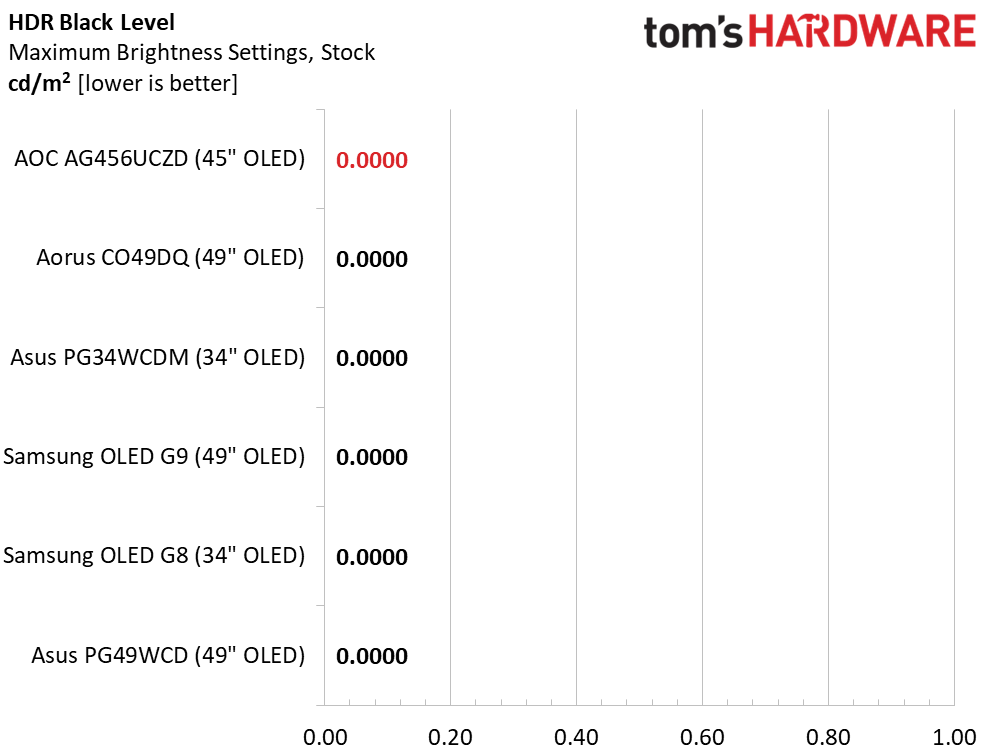
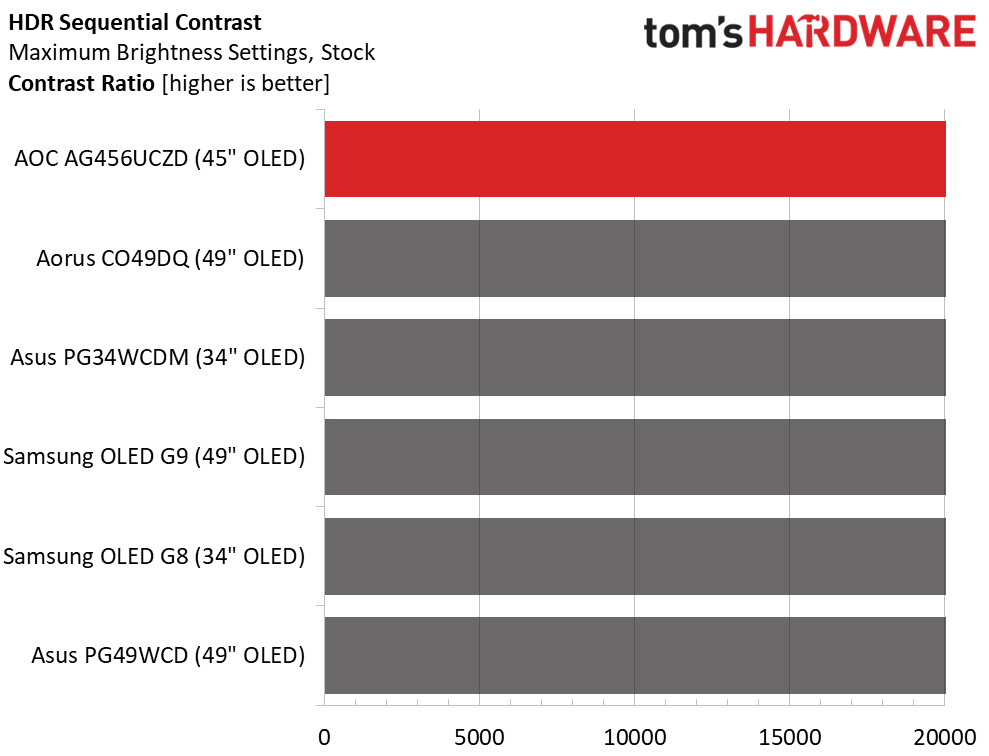
With Constant Brightness turned off, the AG456UCZD tops 635 nits when measuring a 25% window pattern in HDR mode. AOC claims 1,000 nits, which is indeed possible if you measure a small enough area of the image, 3% or less. Brightness? Yes, there is plenty. HDR has a lot of punch, deep contrast, and a true three-dimensional look. Black levels are unmeasurable as usual so I can’t post a contrast ratio.
Grayscale, EOTF and Color
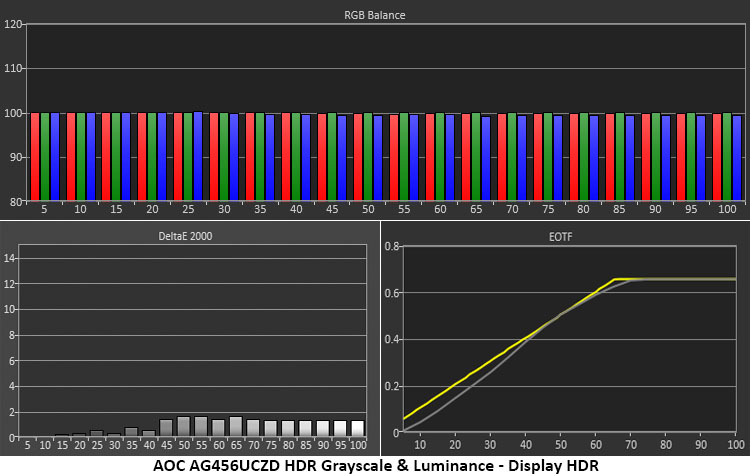
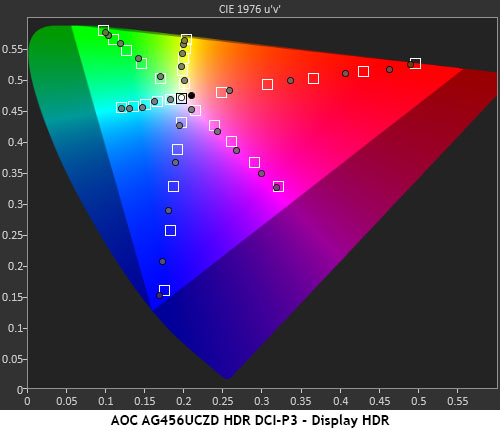
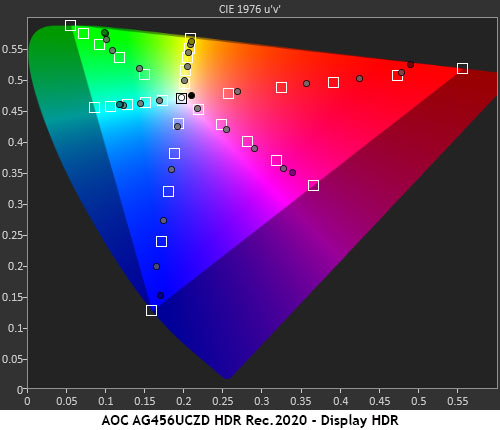
HDR grayscale charts don’t get much better than this. The AG456UCZD’s tracking is visually perfect, with no errors greater than 2dE. The EOTF is a bit dark until it meets the reference line at 40% brightness. The tone-map transition is on-spec at 65% brightness.
The HDR gamut charts show the same level of over-saturation that I see in nearly all HDR monitors, OLED and LCD. This provides a lot of verve to the presentation, and the AG456UCZD manages to track its saturation points linearly. That preserves detail, so you’ll see every nuance contained in the original material. DCI-P3 is fully covered and Rec.2020 runs out at around 85% for red, 75% for green and 95% for blue. This is also typical of the wide gamut displays I’ve tested.
Test Takeaway: The AG456UCZD provides the same stunning HDR image as all the OLEDs I’ve reviewed. In this regard, they are nearly equal. The AOC has a bit more brightness than average, which manifests as stronger highlights. It also has full DCI-P3 gamut coverage, so you’ll see lots of vivid hues in all HDR content. In this regard, it gives nothing away to other similar screens.
I’ve been saying for a while that there are no bad OLED monitors. I’ve been reviewing them almost without letup for months now and have yet to find one that wasn’t excellent in every respect. Yes, there are minor issues here and there, but when taken as a whole, the genre guarantees success. The only question is, what size and shape best fits your needs?
If first-person shooters and sims are your thing, ultra and mega-wide screens create the best version of virtual reality short of a set of goggles. You can have aspect ratios of either 21:9 or 32:9, but 21:9 is where the height is. If you’ve found 34-inch screens a bit underwhelming, the AOC Agon Pro AG456UCZD at 45 inches creates its own category. And it doesn’t cost significantly more either.

With WQHD 3440x1440 resolution, the AG456UCZD has only 83ppi pixel density. But in my experience, that made no difference whatsoever. OLED contrast and color more than compensate. The SDR picture was extremely colorful and the HDR picture is on another level from anything possible in the LCD camp. It has the same infinite blacks and contrast as any OLED, but its size and shape are unique.
Also equal to the very best is the AG456UCZD’s video processing. Though it needs to run over 200fps to be at its best, that means perfect motion resolution with no motion blur. Moving objects retain every scrap of detail and are equal in sharpness to static parts of the image. Fast camera pans come with no artifacts or breakups. It’s one aspect of display performance where OLED can be said to be perfect.
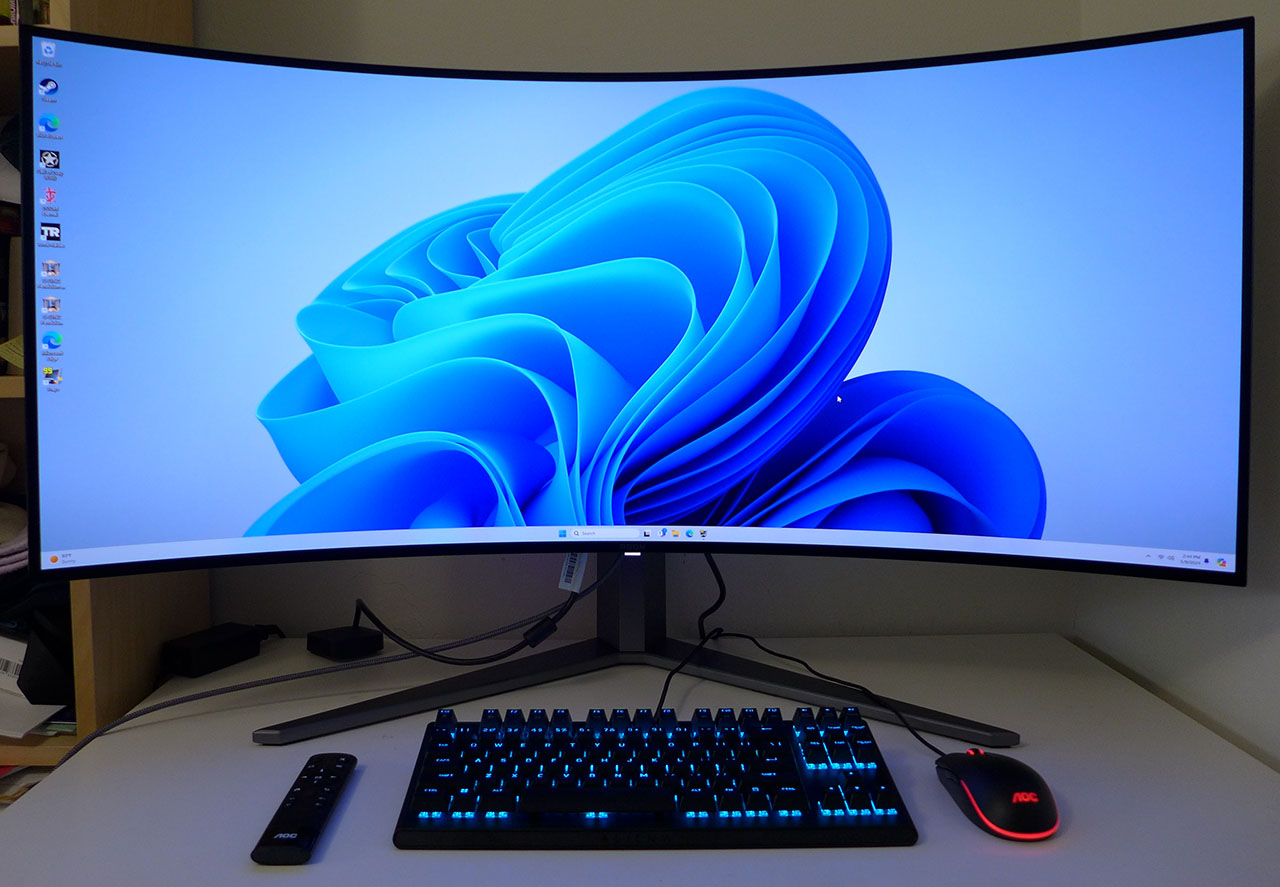
My only nitpick here is the compromise I had to make with gamma. There isn’t an option that tracks 2.2 perfectly but by changing one setting, I was able to make an improvement. And the default image was fine to begin with so take these comments for what they are, nitpicks.
The AOC Agon Pro AG456UCZD is yet another superb OLED gaming monitor. It’s unique in size and shape. There isn’t another display like it. And it doesn’t cost much more than a 34-inch 21:9 screen while offering a lot more immersion and superior sound. If you have the desire for VR glasses but don’t want to spend even more money, the AG456UCZD is clearly worth checking out.







